|
|
Post by mikelmidnight on Mar 19, 2021 11:33:04 GMT -5
Then, the Prof bursts into Johnny's room and tells him he has found a formula for coordinating gravity and electricity and demonstrates.... 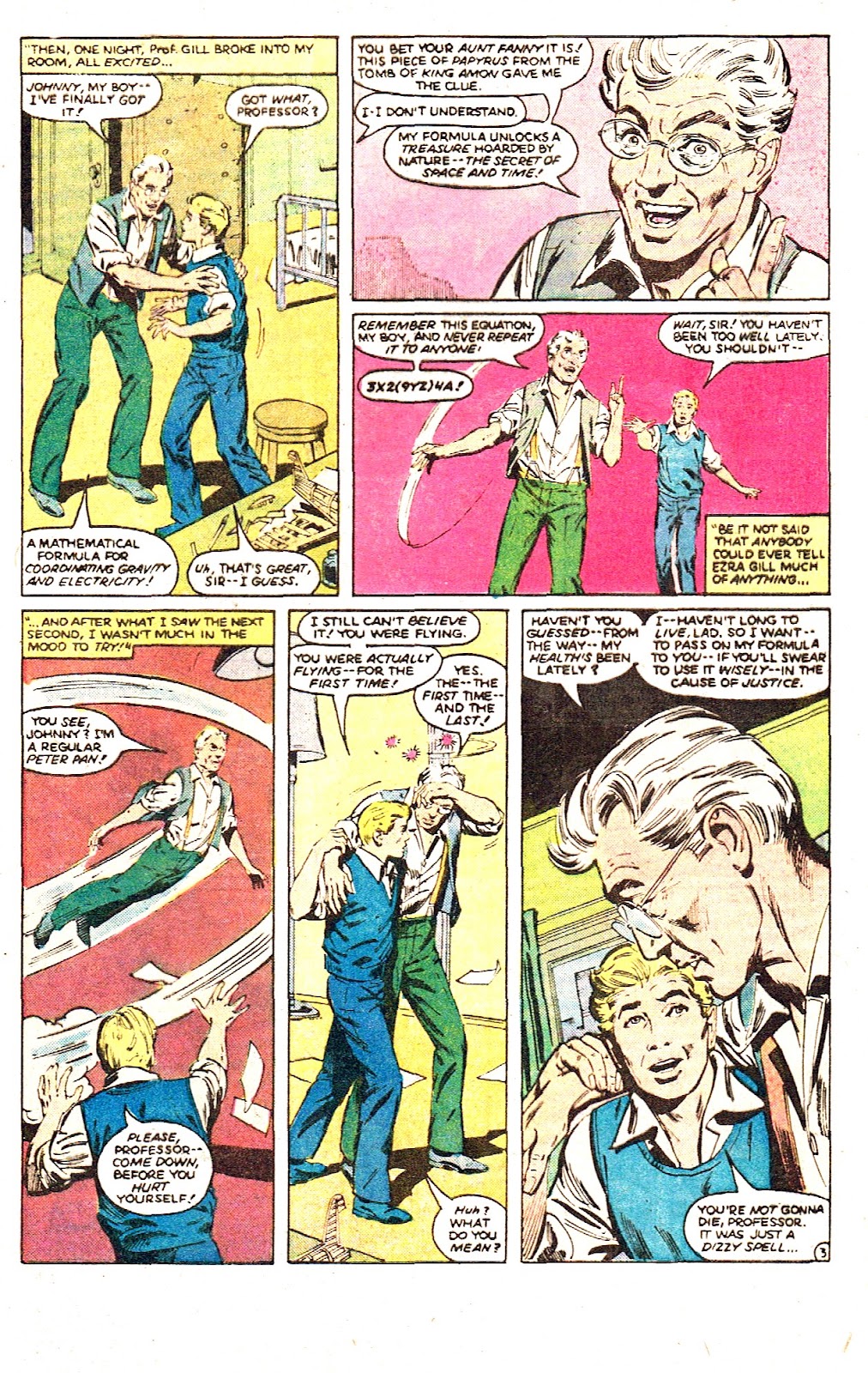
One retcon in this telling, is that originally Prof Gill discovered the "equation" on an ancient Egyptian scroll. Not a single writer has explored the implication that there was at least one ancient Egyptian speedster.
(I vote for Heru, one of the earliest pharaohs, and an incarnation of Horus… since clearly Horus subconsciously influenced Johnny's costume design, with its hawk emblem).
|
|
|
|
Post by codystarbuck on Mar 19, 2021 11:36:01 GMT -5
Then, the Prof bursts into Johnny's room and tells him he has found a formula for coordinating gravity and electricity and demonstrates.... 
One retcon in this telling, is that originally Prof Gill discovered the "equation" on an ancient Egyptian scroll. Not a single writer has explored the implication that there was at least one ancient Egyptian speedster.
(I vote for Heru, one of the earliest pharaohs, and an incarnation of Horus… since clearly Horus subconsciously influenced Johnny's costume design, with its hawk emblem).
Kind of surprised it didn't turn up in the JSA sequence, in ancient Egypt, when they relate a Thanagarian ship being the source of the Nth metal found by Khufu. It included the wizard Shazam and Teth Adam, as well as Nabu. I think Johns and Goyer missed a trick, |
|
|
|
Post by commond on Mar 21, 2021 6:43:56 GMT -5
Not sure if this has been mentioned before, but I just read a letter from T.M. Maple that says the Japanese surrender on September 1st, 1945 would have been reached during issue #492 cover-dated August 2022. We're almost there!
|
|
|
|
Post by codystarbuck on Mar 21, 2021 10:33:59 GMT -5
Not sure if this has been mentioned before, but I just read a letter from T.M. Maple that says the Japanese surrender on September 1st, 1945 would have been reached during issue #492 cover-dated August 2022. We're almost there! Yeah, closest we got was in James Robinson's The Golden Age, where he relates the ending of things as the A-Bomb, and Manhunter on a mission to assassinate Hitler and discovering a secret that is center to the story. Robinson kind of bridged the gap between the All-Star issues, the Squadron series and the later history, as established by Paul Levitz, in Adventure Comics. I didn't mention that specific letter; but, my frustration with the passage of time is part of why I went with a running narrative of the war, in the historical notes. |
|
|
|
Post by codystarbuck on Mar 26, 2021 15:44:29 GMT -5
All-Star Squadron #66 Creative Team: Creative Team: Roy Thomas-writer/editor, Alan Kupperburg-pencils, Tony DeZuniga-inks, Cody Weiss-letters, Carl Gafford-colors Based on Star-Spangled Comics #1, by Mort Weisinger and Hal Sharp Synopsis: Tarantula comes along and busts up a bank robbery, apparently carried out by Rocky & Mugsy, from the Bugs Bunny cartoons.... 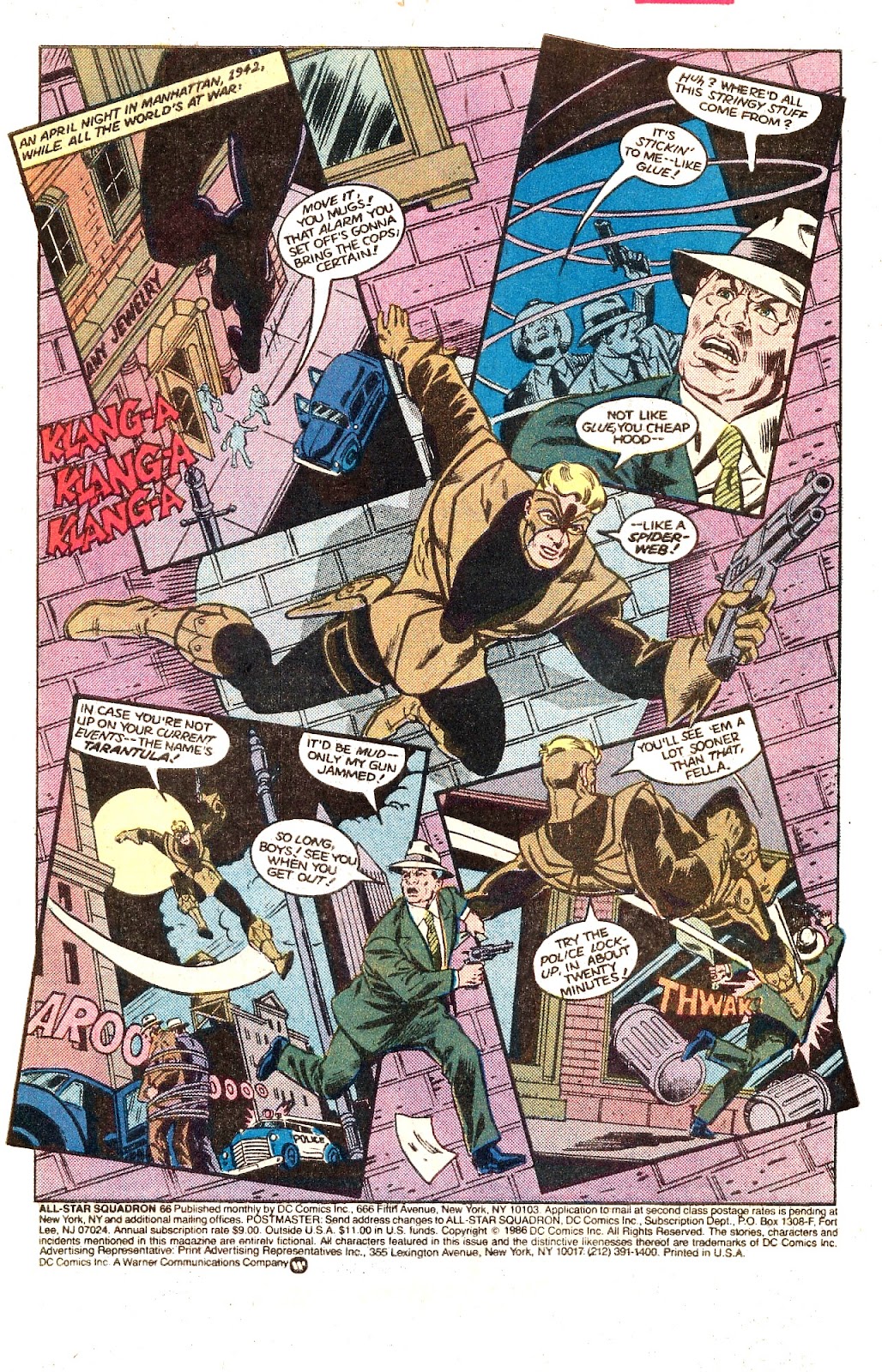 After cornering the hoods, he heads home so that Olga can mother-hen him, while he reads the paper (in a smoking jacket, of course). He reflects on his origin, as you do, when you are a mystery man, in April, 1942 (Sheesh, they never made it to May). He grew up in Missouri (Gee, I wonder why Roy picked there?) and read Sherlock Holmes, tinkered with electronics, collected spiders and wrote stories. Eventually he headed off to New York, to be a writer and wrote a bestseller, called Web of Hate. That was followed by a string of mysteries, a penthouse apartment, and Olga, a housekeeper who fled the Nazis (and is portrayed rather as a Jewish mother stereotype). He happened upon the Sandman beating up a crook one night (as you do) and was inspired to become a mystery man, himself. 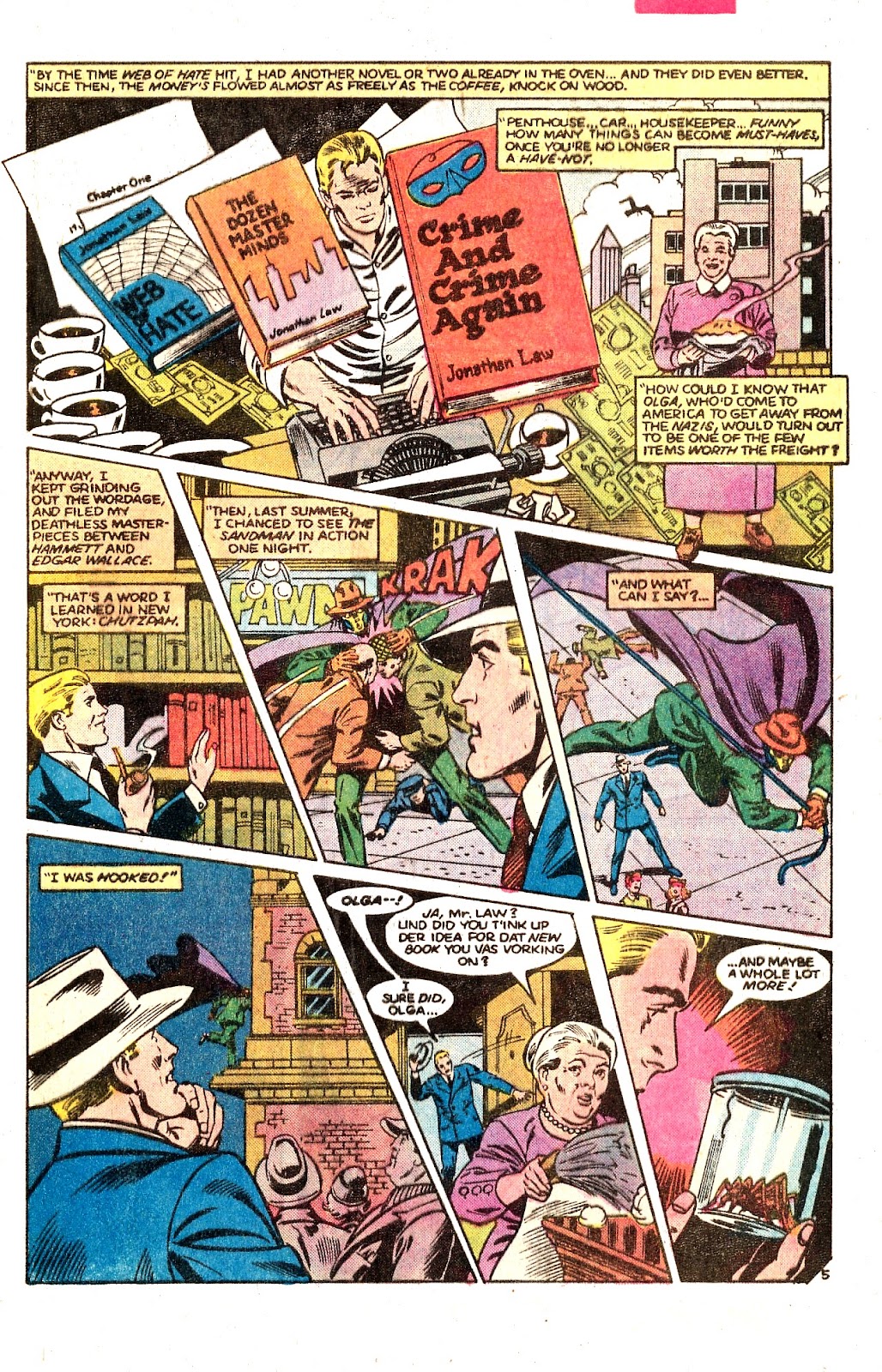 Jonathan sets up an interview with Dian Belmont, who knows the Sandman, for a book he is writing on the new mystery men. After assuring her he doesn't want details about his private life, they talk and she shares a sketch she did for a new costume for Sandman, a yellow bodysuit, purple trunks, mask and cape. Dian tells him to keep the sketch and hints that she knows what is going on in his head. He works out and and creates his web gun and suction boots and Olga makes him the costume... 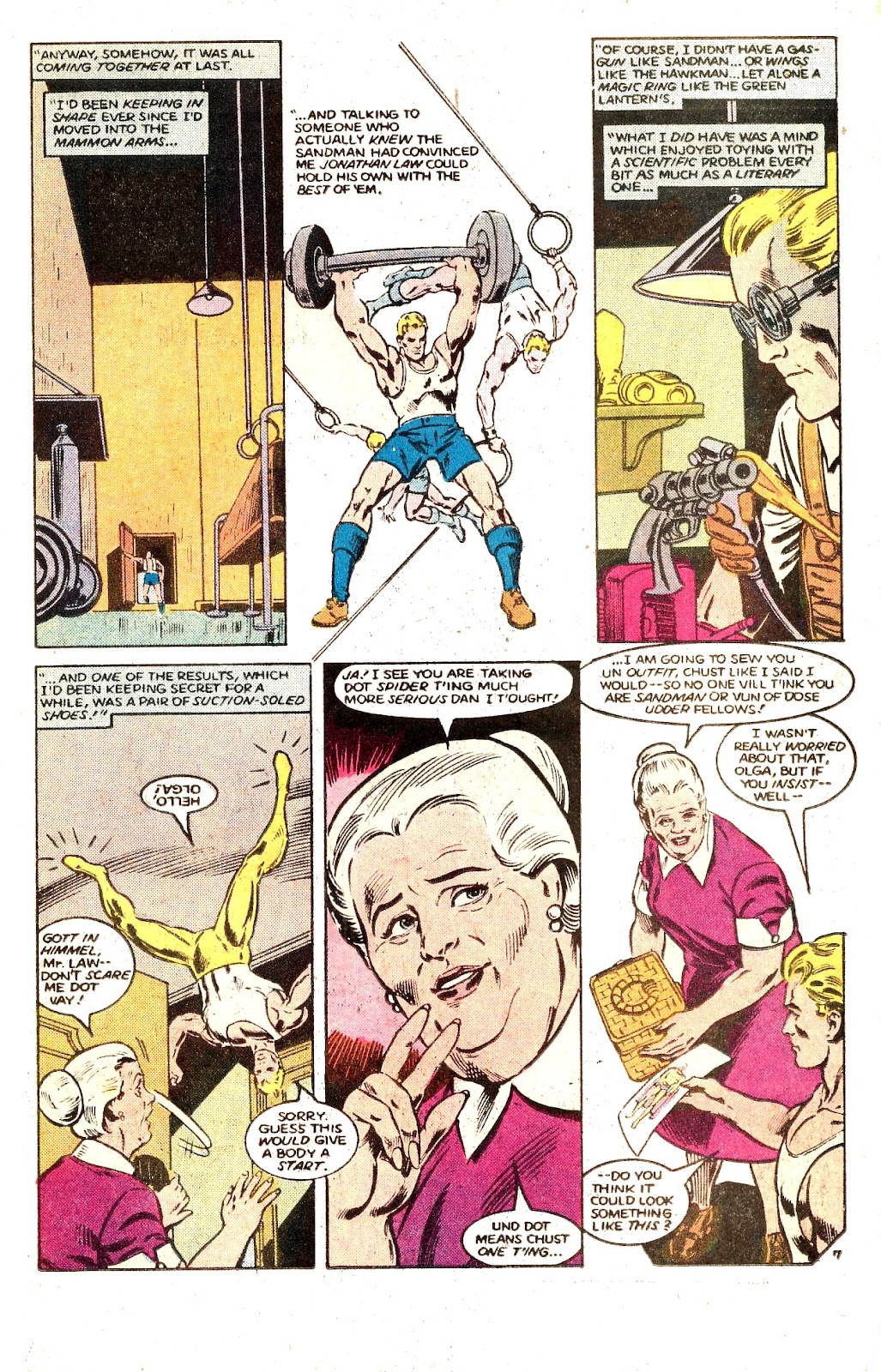 He goes out and comes across a fire and some Nazi saboteurs and kncoks some heads and then aids Sandman, who is wearing his new costume.... 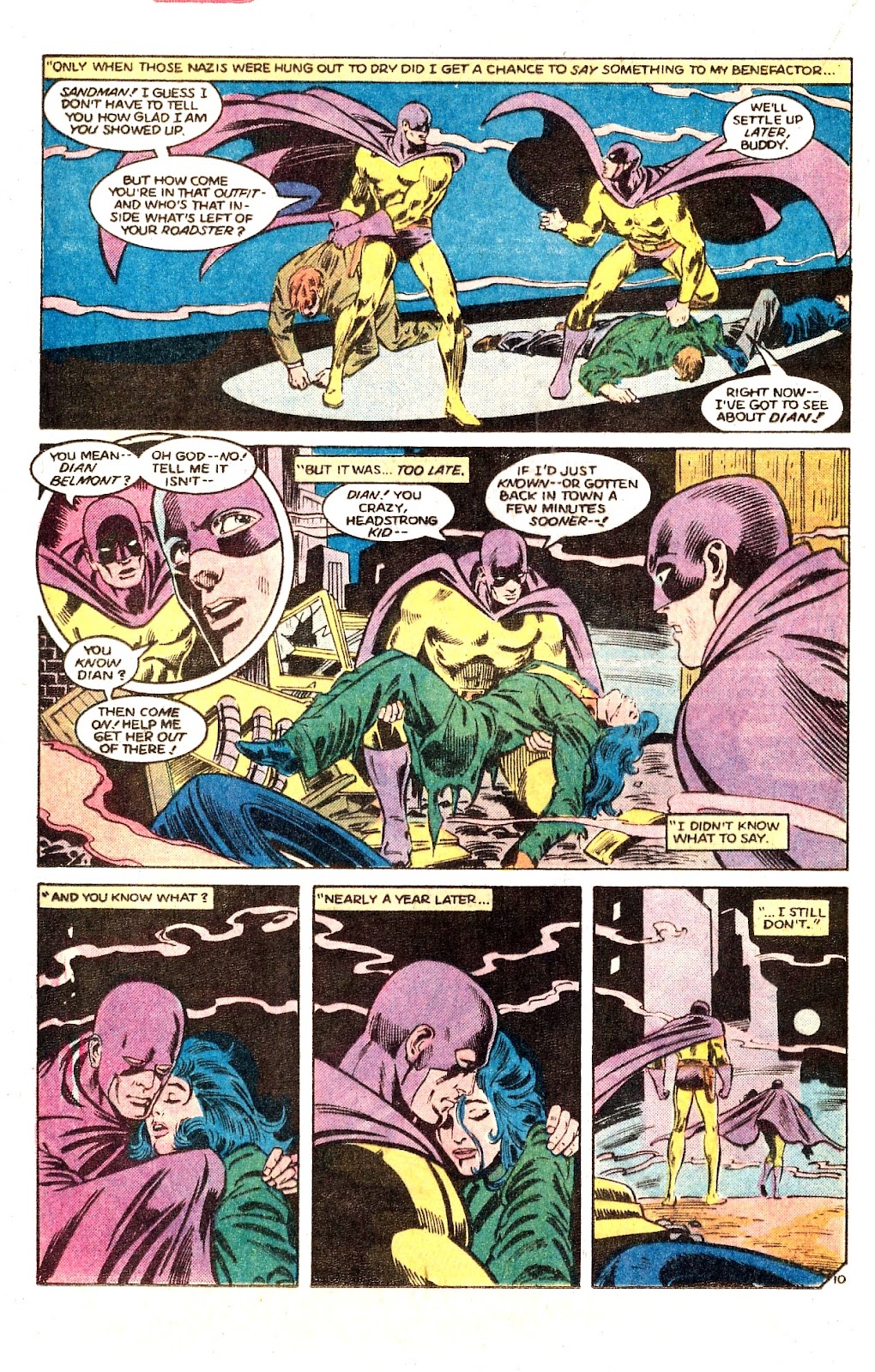 Dian was hurt in the fight and Sandman takes her away, while Tarantula shares the guilt. A few nights later, a gangster named Ace-Deuce pulls a job at a Broadway theater and the Tarantula makes his public debut, capturing the thugs... 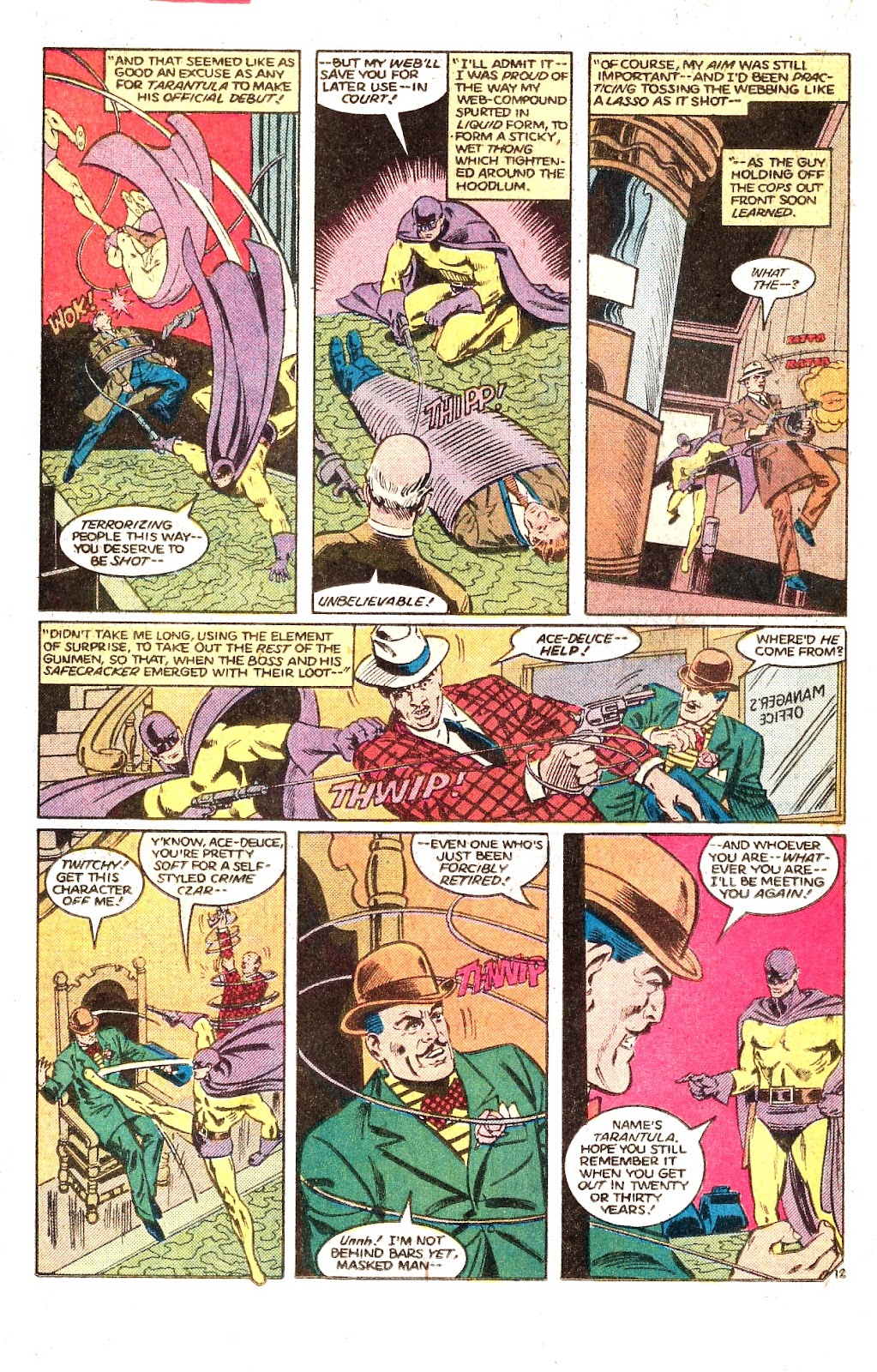 Later, Ace-Deuce breaks out of jail, swearing to get the Tarantula. his men are looking for one Pugs O'Bannion, an elevator expert. Tarantula overhears this (of course) and impersonates O'Bannion. Ace is out to hit a charity do at the top of Radio City and wants O'Bannion to delay the elevators, while they hit the joint. The party is filled with celebs... 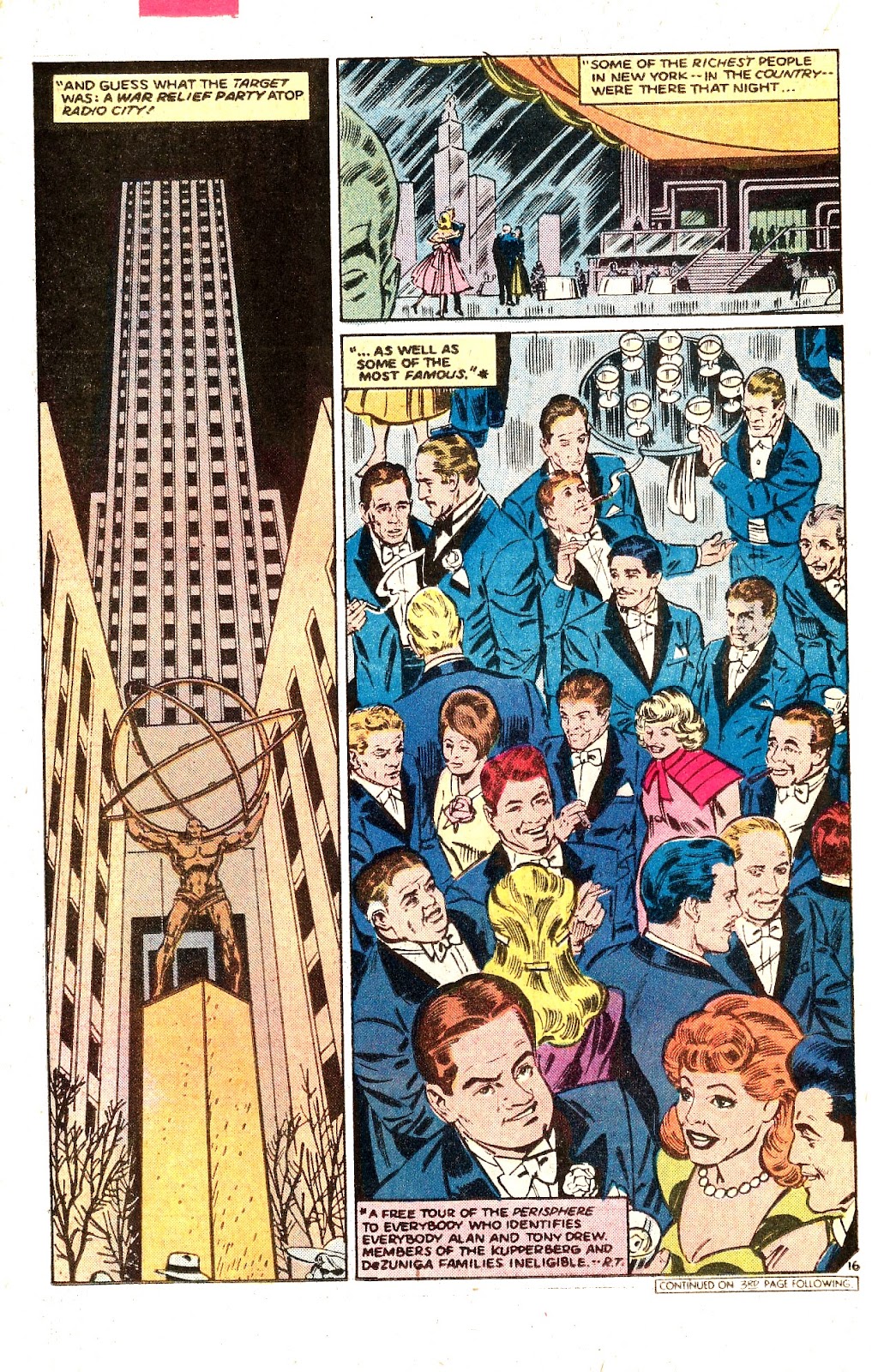 They rob the joint and call in an autogyro to escape. Tarantula nabs the hoods, but misses the autogyro. he fires the web gun, which fouls the rotors and the craft has to land again. They fire a hail of bullets at Tarantula. Tarantula disarms Ace, who jumps over the side with a parachute and Tarantula swings down and lands on the parachute canopy, causing it to lose the pocket of air and Ace plummets to his death. 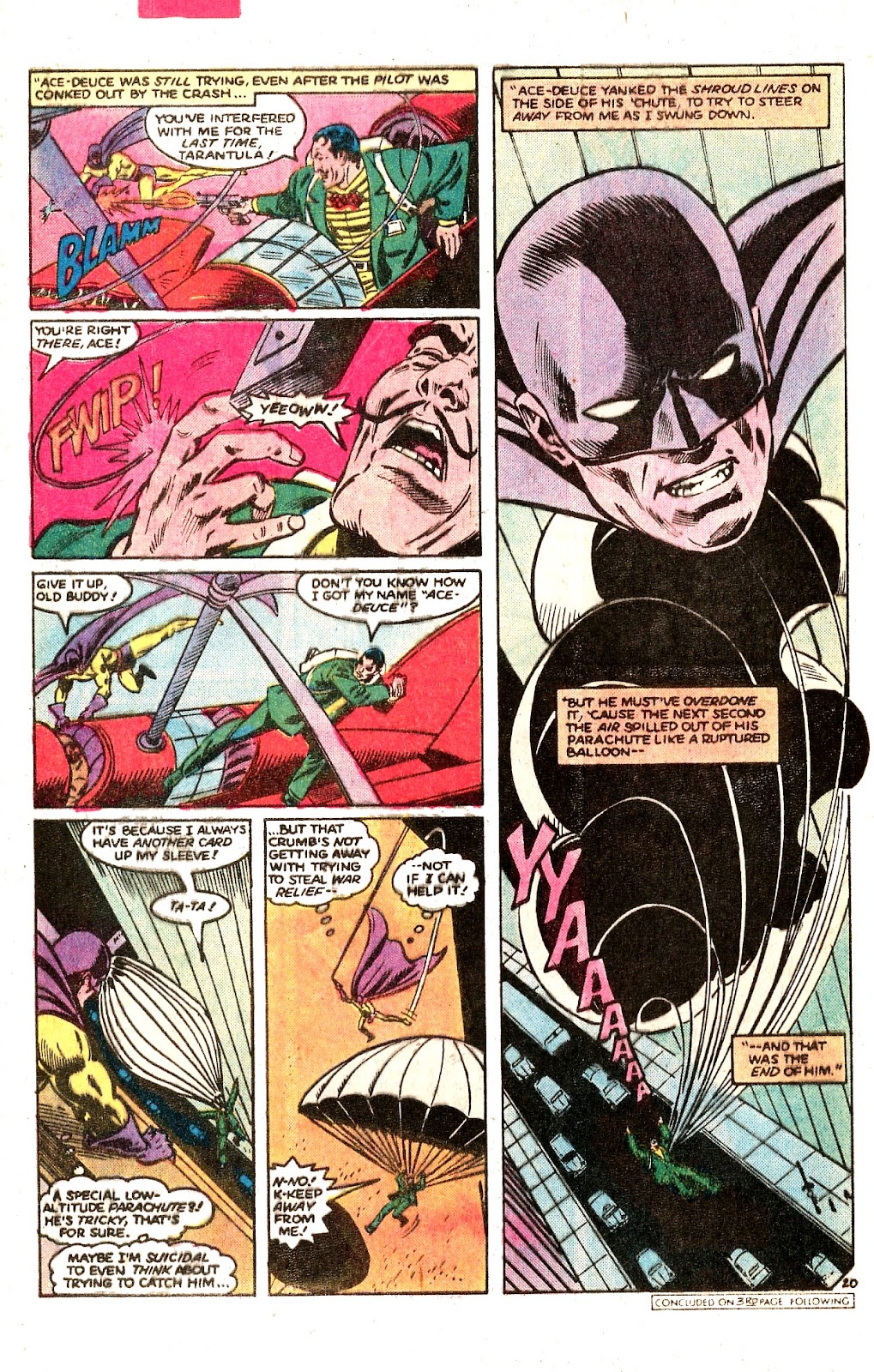 Tarantula makes it home alive and happy, to Olga and later meets the All-Star Squadron, dons his new duds and helps fight Nazis and criminals. The issue finishes with a sweet Eduardo Barreto pin-up of Hawkman... 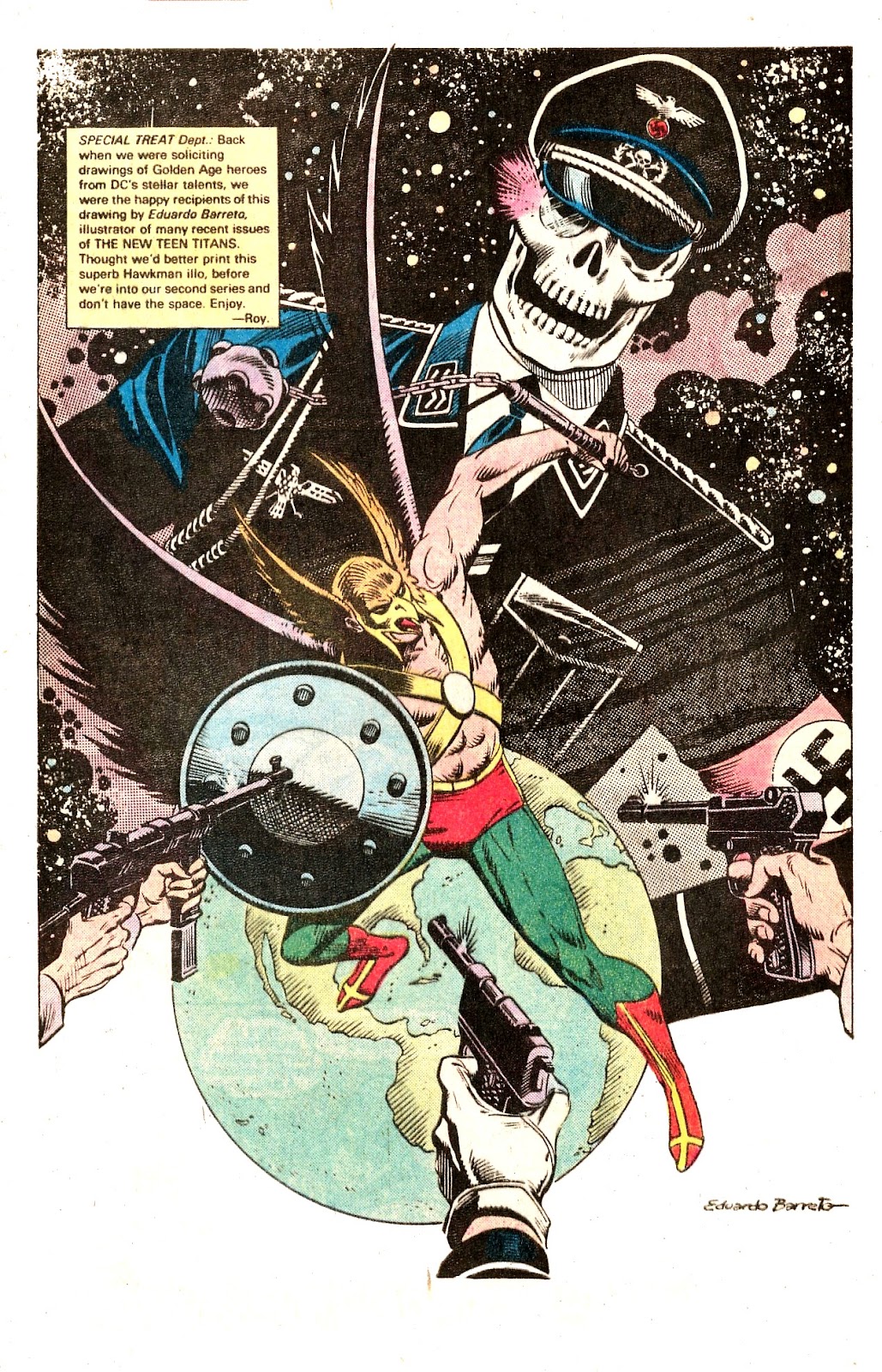 Thoughts: Thoughts: Fun stuff, in the tradition of the Golden Age comics and pulp stories (from which the comics swiped, liberally). The segment where Tarantula fights Ace-Deuce is taken from the original Tarantula story, in Star-Spangled Comics #1 (which starred the Star-Spangled Kid & Stripesy, and also featured Captain X, an aviator her fighting the Nazis, who try to dam the English Channel) and the rest comes from Tarantula's All-Star Squadron debut, as conceived by Roy and Adrian Gonzales, back in issue #18. Guess Roy decided to throw his own childhood in there for Jonathan Law, with the Missouri bit. New York seems a long way to go to become a writer, when there were multiple large publishing houses in Chicago. Typical East Coast snobbery! Roy makes several jokes about Tarantula being called Spider-Man, though that actually occurs in Star-Spangled #1, which Roy pretty much repeats, verbatim. The connection to Sandman and Dian Belmont is all Roy, though. The party features caricatures of bob Hope, Humphrey bogart, Edward G Robinson, Clark Gable, and several who are not recognizable enough to me, though one pair might be Abbot & Costello. One appears to be Ronald reagan and the All-Star Companion, Vol 2, says the redhead is Lucille Ball and the man on her right is Desi Arnaz, who married in 1940, when the story is set. I thought it might be her, but it isn't the best likeness. Desi is in profile and it could be anyone, from what you see. I believe George Raft is in there, too. So, we have just one more issue for this series, before the launch of Young-All-Stars, which I will also cover. Historical Notes: Nothing much. Jonathan Law mentions concentration camps, which may seem like a mistake; but, it was public knowledge, in some circles, the Hitler had set up concentration camps for political dissidents, as early as 1933, with Nohra, in Thuringa. The inmates were mostly political prisoners, Social democrats and Communists, who opposed the Nazi Party. This was further expanded and institutionalized, as the Nazis consolidated power. Dachau soon followed, situated on the site of a former munitions plant, in Bavaria, near Munich, the seat of Nazi tradition. It became the model for all other camps and remained in operation, until the end of the war. The first major Jewish consignment to the camp came in 1938, after Kristallnacht, when 30,000 Jewish adult males were sentenced to the camps, with 10,000 sent to Dachau. The radio mentions North Africa, which was the scene of the desert war between the British and the Germans & Italians. The charity party is in aid of British relief, referring to the fighting and the Battle of Britain. March 1945 In the Pacific, the war continues to go badly for the Japanese. American and Filippino troops liberated manila, capital of the Philippines, while the British liberated Mandalay, in Burma. On Iwo Jima, the fighting came to an end (with a few holdouts) and eyes turned to Okinawa. The US began the B-29 bombing campaign of the Japanese Home Islands, on March 9-10. B-29s, based on the captured islands of the Marianas (such as Tinian and Guam) carried out a raid on the capital of Tokyo, dropping incendiary bombs on the city. because of the heavy use of wood and paper in Japanese traditional construction, planners felt the city would be especially vulnerable to incendiary bombs. Japan had made air defense of Tokyo a priority, but had a shortage of radar equipment and fire control systems, making its anti-aircraft efforts more difficult, during night raids. Air defense included night fighter units, but, they had expected high altitude attacks, not the low altitude bombing mission that occurred. 325 bombers were launched, with 279 dropping bombs on targets, throughout the city. !600= tons of bombs were dropped, igniting fires throughout the city, which created firestorms, engulfing whole neighborhoods. Estimates of casualties range from 79,000 to 124, 000 dead or wounded, roughly the equivalent to the dead in either Hiroshima or Ngasaki, from the Atomic Bombs.  Further raids were carried out on Nagoya, Osaka and Kobe. The government initially suppressed the information, then used it for propaganda, but Japanese civilian morale was shaken and the raids proved to them that the government had not been reporting had badly the war was going, shaking their faith in their leaders. On the Eastern front, the Russians launched an offensive in Upper Silesia and pushed the Germans out of Hungary and into Austria. The German 4th Army was nearly completely wiped out at the Heiligenbeil Pocket, in East Prussia In the Netherlands, resistance fighters ambush SS Obergruppenfuhrer Hans Albin Rauter. He is wounded, but survives and the Germans carry out reprisals, killing 117 civilians. The USAAF carried out raids on Swinemunde (killing between 8 and 23,000 civilians, including refugees who had been evacuated from the eastern front), Wurzburg (destroing 89% of the city and killing over 4,000) and a 1000+ plane raid on Berlin. Hitler gives orders to destroy all military installations, industries, rail transport, machine shops and communications facilities. Most of these orders are ignored or subverted, via efforts of people like Albert Speer. The Allies in the West carry out operations to seize bridges on the Rhine and move troops across into Germany. Operation Lumberjack, centering on the US First Army sought to attack at the juncture of the Ahr and the Rhine and capture the city of Cologne, then push south to link up with Patton's 3rd Army, which was to drive northward, through the Eifel. There would then be a pause, while Montgomery carried out Operation Plunder, with the target of Dusseldorf, crossing over the Dutch border. The operation began on March 1 and the Army quickly exploited bridgeheads and captured Cologne on the 7th. The 3rd Army faced tougher resistance; but, succeeded in punching a hole through German lines and the 4th Armored Division poured through and crossed 45 miles to the Rhine, in 5 days, suffering only 100 casualties and just missing the chance to seize a bridge at Urmitz. Also on March 7, elements of the 9th Armored Division Combat Command B, 9th Armored Engineer Battalion discovered a rail bridge, The Ludendorff Bridge, near the town of Remagen, still standing. The Germans attempted to demolish the bridge with explosive charges, but many of them failed and the bridge survived and was captured intact. orders were given to immediately move troops across and some 6 divisions, approximately 25, 000 men and equipment, established a beachhead on the other side of the Rhine. Eisenhower altered his plans, seizing the opportunity, taking focus away from Operation Plunder and using their advantage to encircle the Ruhr, the industrial heart of Germany. German High Command was shaken, as it signaled that the defense of Germany was no longer possible, long term. Effective German forces were cleared along the Rhine, north of Mossel, with 4 corps of the 15th and 7th German Army destroyed in the fighting. On March 24, the Allies carried out Operation Varsity, the largest airborne operation of the war, as 16,000 paratroops were dropped on the German side of the Rhine, in support of Operation Plunder.  The mistakes of Operation Market garden were not repeated, as airborne units were dropped in close conjunction with amphibious crossings, so that there was no delay in link up. Amphibious troops actually launched their assualt first, with the paratroops dropped in to create chaos and cut off response to the landings, so that they, in turn, could quickly reinforce the paratroops. The US 17th Airborne Division had the baptism by fire in the battle, making their first combat drop. The British 6th Airborne landed in 3 drop zones, where they met intense fire, but succeeded in clearing the area of German forces and glider troops succeeded in capturing the town of Hamminklein and bridges across the River Issel. They were aided by troops from the US 513 Parachute Infantry regiment, who landed in the wrong area; but quickly adapted to the situation. The 17th Airborne were concentrated around the town of Diersfordt and the 507th PIR was planned to land with the entire regiment concentrated together, though visibility issues led to them being split in two groups. however, strong leadership overcame the diffculty and they silenced an artillery battery and cleared the area. The 513 PIR also secured its objectives, despite a portion landing in the wrong area. The 194th Glider Infantry Regiment landed in heavy anti-aircraft fire and suffered heavy casualties; but, succeeded in overcoming the artillery units and secured its area. The Diersfordter Forest was clear of German troops and roads that could bring in reinforcements were cut off from the Germans. Artillery batters were silenced and the town of Hamminklein was in Allied hands. 3 bridges across the Issel had been seized, though one later had to be destroyed to block a German counter-attack. Engineers quickly began erecting light bridges across the Rhine, with the first completed by midnight. By March 27, 12 bridges had been constructed which could support heavy armor. If you have seen Band of Brothers, this is the operation in which Lewis Nixon takes part, barely getting out of his C-47, before it is hit and explodes. Captain Lewis Nixon was attached to Gen Maxwell Taylor's staff and was attached as an observer to the 17th Airborne. Only he and 3 others escaped the plane, before it went down. Captain Nixon was one of the few members of the 101st to have 3 combat stars on their jump wings (Normandy, Market Garden and Varsity). The Allies in the West were now in Germany and poised to move towards Berlin. In the East, the Red Army and its Allies had cleared most of Poland and Hungary and were pushing in in Czechoslovakia and were at the borders of Austria and Germany. Nazi Germany's days were near the end. On March 8, Allen Dulles secretly met with SS obergruppenfuhrer Karl Wolff, in Bern, Switzerland, to discuss the surrender of northern Italy to the Allies. Wolff intended to surrender the area to the Allies to withdraw 800,000 troops to defend Vienna, against the Red Army. The Soviets were notified of intentions and agreed, provided their own military was present, which was denied. This led to diplomatic incidents that nearly wrecked the Alliance with the USSR.
|
|
|
|
Post by mikelmidnight on Mar 29, 2021 11:27:30 GMT -5
Dian was hurt in the fight and Sandman takes her away, while Tarantula shares the guilt. A few nights later, a gangster named Ace-Deuce pulls a job at a Broadway theater and the Tarantula makes his public debut, capturing the thugs...
I think she was actually killed in the story? This is one of my real pet peeves with Roy!
Tying together Sandman and Tarantula given their near-identical costumes was a fairly harmless retcon to me. However, Roy clearly killed off Dian solely to 'explain' why she didn't appear in the S&K stories.
Dian wasn't a pesky Lois Lane/Vicki Vale type. She was his partner in detection and deserved better simply to die to 'explain' why she wasn't around for a while.
The implication of the story is that Dian wanted to know what it was like to be the Sandman, but … wasn't any good at it? Except that there was already a 40s story in which Wesley had been kidnapped, and Dian dressed as Sandman to rescue him. So she already had experience, and was quite competent.
Additionally, this story took place before the 'All-Girl JSA' story in which Sandman's girlfriend plays a part. Granted, she was never named, but there were never any other candidates for the role. So it not only misrepresented a female character but violated his precious continuity.
As you can guess, I always liked Dian and have a mad-on for this tale. I've always been fascinated with the partners and girlfriends you'd see occasionally (Hawkgirl was another one) who never felt the need to become full-time superheroes but who were perfectly willing to don costume and help out when required (or when they were just bored and wanted to do it for kicks, whatever!).
|
|
|
|
Post by Prince Hal on Mar 29, 2021 11:43:21 GMT -5
My Gawd, those drawings if the celebrities... Drop dead awful. If you can't capture their likenesses, don't includde them. the reader should never have to guess.
I know the printing was also drop dead awful on DC Comics then, but sheesh!
Bob Hope looks like a caricature, not an illustration. Who has a head shaped like that? Is that Adolphe Menjou on the upper right?
Reagan, Lucy and Bogey are recognizable, but the rest could have been anybody.
My guess is that it was one more example of Roy's OCD insisting on something even though basically any comics fan could have told you that neither Kupperburg nor De Zuniga could deliver the kind of realistic portraits he wanted.
|
|
|
|
Post by codystarbuck on Mar 29, 2021 19:51:34 GMT -5
Dian was hurt in the fight and Sandman takes her away, while Tarantula shares the guilt. A few nights later, a gangster named Ace-Deuce pulls a job at a Broadway theater and the Tarantula makes his public debut, capturing the thugs...
I think she was actually killed in the story? This is one of my real pet peeves with Roy!
Tying together Sandman and Tarantula given their near-identical costumes was a fairly harmless retcon to me. However, Roy clearly killed off Dian solely to 'explain' why she didn't appear in the S&K stories.
Dian wasn't a pesky Lois Lane/Vicki Vale type. She was his partner in detection and deserved better simply to die to 'explain' why she wasn't around for a while.
The implication of the story is that Dian wanted to know what it was like to be the Sandman, but … wasn't any good at it? Except that there was already a 40s story in which Wesley had been kidnapped, and Dian dressed as Sandman to rescue him. So she already had experience, and was quite competent.
Additionally, this story took place before the 'All-Girl JSA' story in which Sandman's girlfriend plays a part. Granted, she was never named, but there were never any other candidates for the role. So it not only misrepresented a female character but violated his precious continuity.
As you can guess, I always liked Dian and have a mad-on for this tale. I've always been fascinated with the partners and girlfriends you'd see occasionally (Hawkgirl was another one) who never felt the need to become full-time superheroes but who were perfectly willing to don costume and help out when required (or when they were just bored and wanted to do it for kicks, whatever!).
-She was killed in Roy's original All-Star Squadron story; but, she was established as alive after the 40s, in later post-Crisis comics; specifically, Starman. James Robinson has Jack Knight meet Dian Belmont and Wesley Dodd and Dian is who Jack is most nervous to meet. Dian is his literary hero and she is a key factor in solving a mystery they investigate, carrying on the characterization that Matt Wagner gave her, In Sandman Mystery Theater. This issue uses the same narration about a "headtsrong kid;" but never outright says she is dead or shows a grave, like in issue 18. I suspect Roy intended her to be dead; but, Robinson took the ambiguity as a loophole to have her alive in the 2000s. I kind of forgot the earlier death and since the issue didn't state it clearly, I assumed badly injured, especially since we are post-Crisis. Funny enough, I recently came across an interview James Robinson did, in relation to writing a new modern-day Invaders, at Marvel and he talked Golden Age stuff and made a valid mild criticism of Roy in it. he talked about Invaders and how Roy was more unrestrained in crafting exciting stories that reflected the Timely covers, which did not feature interior team-ups with the characters, until the All-Winners Squad (aside from the Namor/Human Torch battle). He then said Roy was a bit too reverent to his beloved DC heroes, trying to rationalize inconsistencies and maintaining every tiny piece of continuity, no matter how inconsequential. I have to agree with that, as I felt Roy got a bit too bogged down in linking to old stories in All-Star Squadron and Infinity, Inc, to the point he was ignoring the opportunity to create new stories and focus more on the types of stories that the readers seem to enjoy. I thought he started strong, with a few minor digressions into continuity fixes; but, by the third year, it was occurring more and more until by the tail end, he was obsessed with stories that only he and Jerry Bails and a few others cared about. By contrast, in Invaders, there was little continuity to go against and Roy was busy crafting a more solid WW2 history for the Marvel Universe. Don't get me wrong, I like Roy's writing and enjoyed the bulk of this series and the majority of Infinity, Inc; but, after a while, both felt like fan fiction for a very select audience. I think he would have benefitted from an outside editor who brought another point of view to his work. I don't think the writer/editor thing works very well, when it isn't entirely your creation. Even then, an editor helps a writer find the weaknesses and fix them or polish up the writing or find a better way to tell the story. |
|
|
|
Post by MDG on Mar 30, 2021 8:42:01 GMT -5
My Gawd, those drawings if the celebrities... Drop dead awful. If you can't capture their likenesses, don't includde them. the reader should never have to guess. I know the printing was also drop dead awful on DC Comics then, but sheesh! .... My guess is that it was one more example of Roy's OCD insisting on something even though basically any comics fan could have told you that neither Kupperburg nor De Zuniga could deliver the kind of realistic portraits he wanted. I think part of that is the style of inking at DC at this time. Possibly as a reaction to a lot of the bad inking in the late 70s-early 80s, the inking style became so tight that if the underlying drawing was off, things really fell apart. In addition, it made a lot of things seem static. (I know some people love 'em, but it really drives me away from the triangle era Supes.)
But I think, left to his own devices, DeZuniga should've been a good enough artist to pull off a decent likeness.
|
|
|
|
Post by mikelmidnight on Mar 30, 2021 11:28:34 GMT -5
-She was killed in Roy's original All-Star Squadron story; but, she was established as alive after the 40s, in later post-Crisis comics; specifically, Starman. James Robinson has Jack Knight meet Dian Belmont and Wesley Dodd and Dian is who Jack is most nervous to meet. Dian is his literary hero and she is a key factor in solving a mystery they investigate, carrying on the characterization that Matt Wagner gave her, In Sandman Mystery Theater. This issue uses the same narration about a "headtsrong kid;" but never outright says she is dead or shows a grave, like in issue 18. I suspect Roy intended her to be dead; but, Robinson took the ambiguity as a loophole to have her alive in the 2000s. I kind of forgot the earlier death and since the issue didn't state it clearly, I assumed badly injured, especially since we are post-Crisis.
I was a fan of Sandman Mystery Theatre and Starman, and pleased by Dian's revival. I also note that in SMT, Dian dons the Sandman uniform as well, to do some investigating. Adding everything up that gives her four or five cases as 'Sandwoman' which isn't too bad.
In terms of her being a "headstrong kid," that also completely ignores her 40s characterisation, unless it's just Wesley being sexist. In fact, in the original series she started out as a cat burglar, the Lady in Evening Clothes, before reforming and becoming Sandman's sidekick.
I had not read this quote but agree completely. The Invaders did feature a few retcons I could have done without, but mainly focused on good characterisation and adventures, while All-Star Squadron was entirely worldbuilding.
Sometimes I think Roy ought to have done the series in the opposite way:
Timely's heroes had been largely undocumented, and a big sprawling series exploring them all would have tightened up their continuity nicely.
DC could have focused on … let's say Superman, Batman, Star-Spangled Kid & Stripesy, maybe? … as a Golden Age 'Super Squad' and focused on the characters in a deep way. It would have been a much better comic, and maybe one of them could have been swapped out later for Steel, if need be.
|
|
|
|
Post by codystarbuck on Mar 30, 2021 11:56:19 GMT -5
-She was killed in Roy's original All-Star Squadron story; but, she was established as alive after the 40s, in later post-Crisis comics; specifically, Starman. James Robinson has Jack Knight meet Dian Belmont and Wesley Dodd and Dian is who Jack is most nervous to meet. Dian is his literary hero and she is a key factor in solving a mystery they investigate, carrying on the characterization that Matt Wagner gave her, In Sandman Mystery Theater. This issue uses the same narration about a "headtsrong kid;" but never outright says she is dead or shows a grave, like in issue 18. I suspect Roy intended her to be dead; but, Robinson took the ambiguity as a loophole to have her alive in the 2000s. I kind of forgot the earlier death and since the issue didn't state it clearly, I assumed badly injured, especially since we are post-Crisis.
I was a fan of Sandman Mystery Theatre and Starman, and pleased by Dian's revival. I also note that in SMT, Dian dons the Sandman uniform as well, to do some investigating. Adding everything up that gives her four or five cases as 'Sandwoman' which isn't too bad.
In terms of her being a "headstrong kid," that also completely ignores her 40s characterisation, unless it's just Wesley being sexist. In fact, in the original series she started out as a cat burglar, the Lady in Evening Clothes, before reforming and becoming Sandman's sidekick.
I had not read this quote but agree completely. The Invaders did feature a few retcons I could have done without, but mainly focused on good characterisation and adventures, while All-Star Squadron was entirely worldbuilding.
Sometimes I think Roy ought to have done the series in the opposite way:
Timely's heroes had been largely undocumented, and a big sprawling series exploring them all would have tightened up their continuity nicely.
DC could have focused on … let's say Superman, Batman, Star-Spangled Kid & Stripesy, maybe? … as a Golden Age 'Super Squad' and focused on the characters in a deep way. It would have been a much better comic, and maybe one of them could have been swapped out later for Steel, if need be.
I was pretty happy with the team established in the first year and would have enjoyed that continuing to the end, with others revolving in and out. As it was, he mostly stuck with Liberty Belle, Johnny Quick, Robotman and and Firebrand from beginning to end, though I would have liked Atom and Steel to have been a more constant presence. What i really would have enjoyed a bit more is Roy building a recurring set of villains to fight them, as he did in Invaders. There, he had his German Justice League, with Master Man, Warrior Woman, U-Man and baron Blood, plus figures like Brain Drain and the Red Skull. Loved those issues. Would have liked more of the Ultra-Humanite group or something along those lines. Not a fan of the revised Monster Society bunch, as they came off a 5th string losers. Baron Blitzkrieg leading some German uber-agents would have been nice, long term and I would have liked to have seen more with Dragon King, rather than the later Japanese team (or just better characterization, with them). |
|
|
|
Post by codystarbuck on Apr 3, 2021 15:48:25 GMT -5
All-Star Squadron #67 Last issue!! Creative Team: Roy Thomas-writer/editor, Arvell Jones-pencils, Tony Dezuniga-inks, John Clark-letters, Carl Gafford-colors No Cody Weiss, for the last issue. Funny enough, I believe we had more personnel changes for the pencilers and inkers than letters or colorists. As has been usual at this period, based on a Golden Age story: All-Star Comics #4. Synopsis: The JSA are in Washington, to meet with J Edgar Hoover, to root out Commies and pinko subversives, while exchanging hair and make-up tips.... 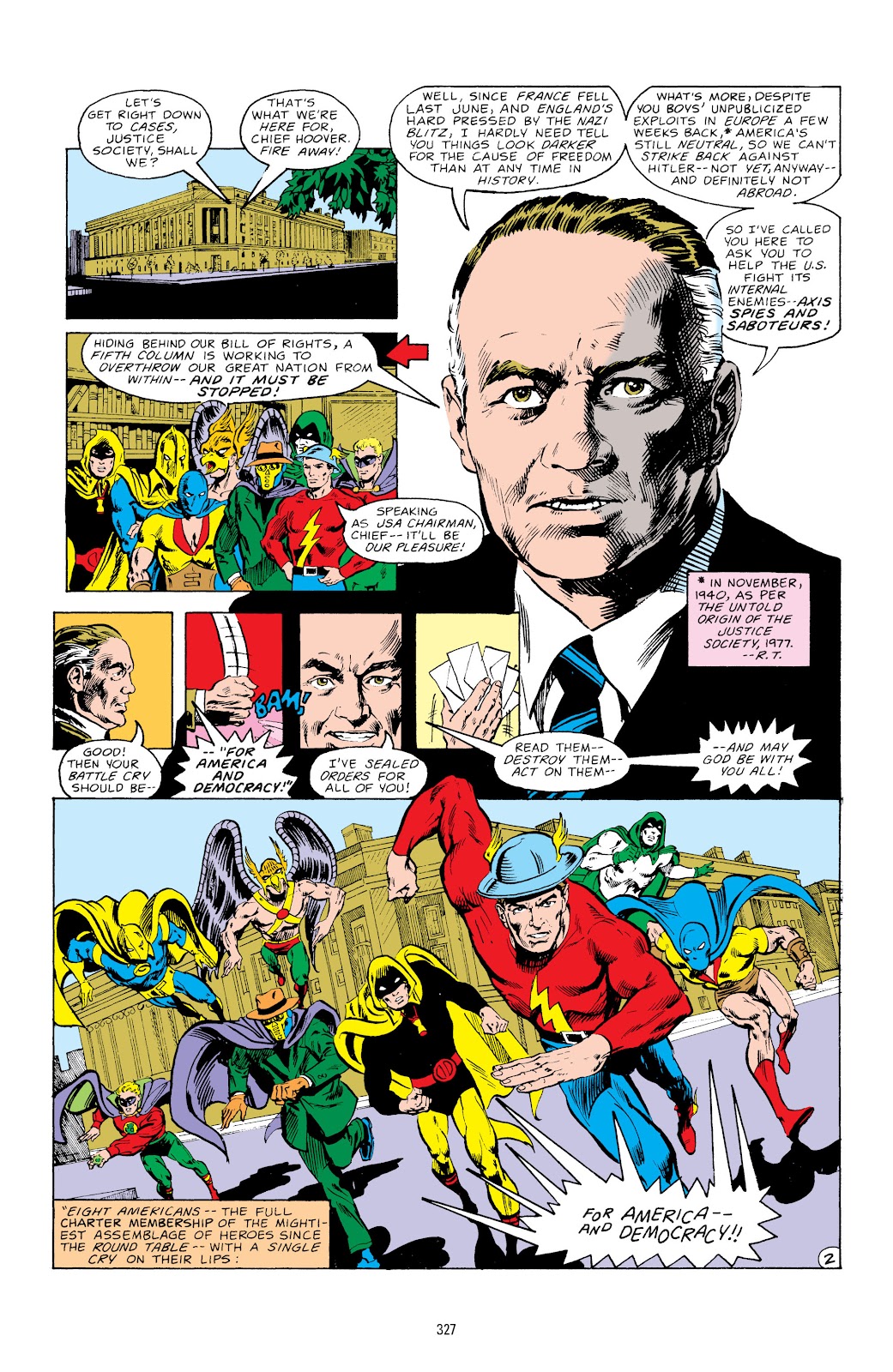 They take their orders and go hunting for subversives and saboteurs. Green Lantern deals with Ratzis who are trying to disrupt radio broadcasts, while pressuring a German-American to aid them.... 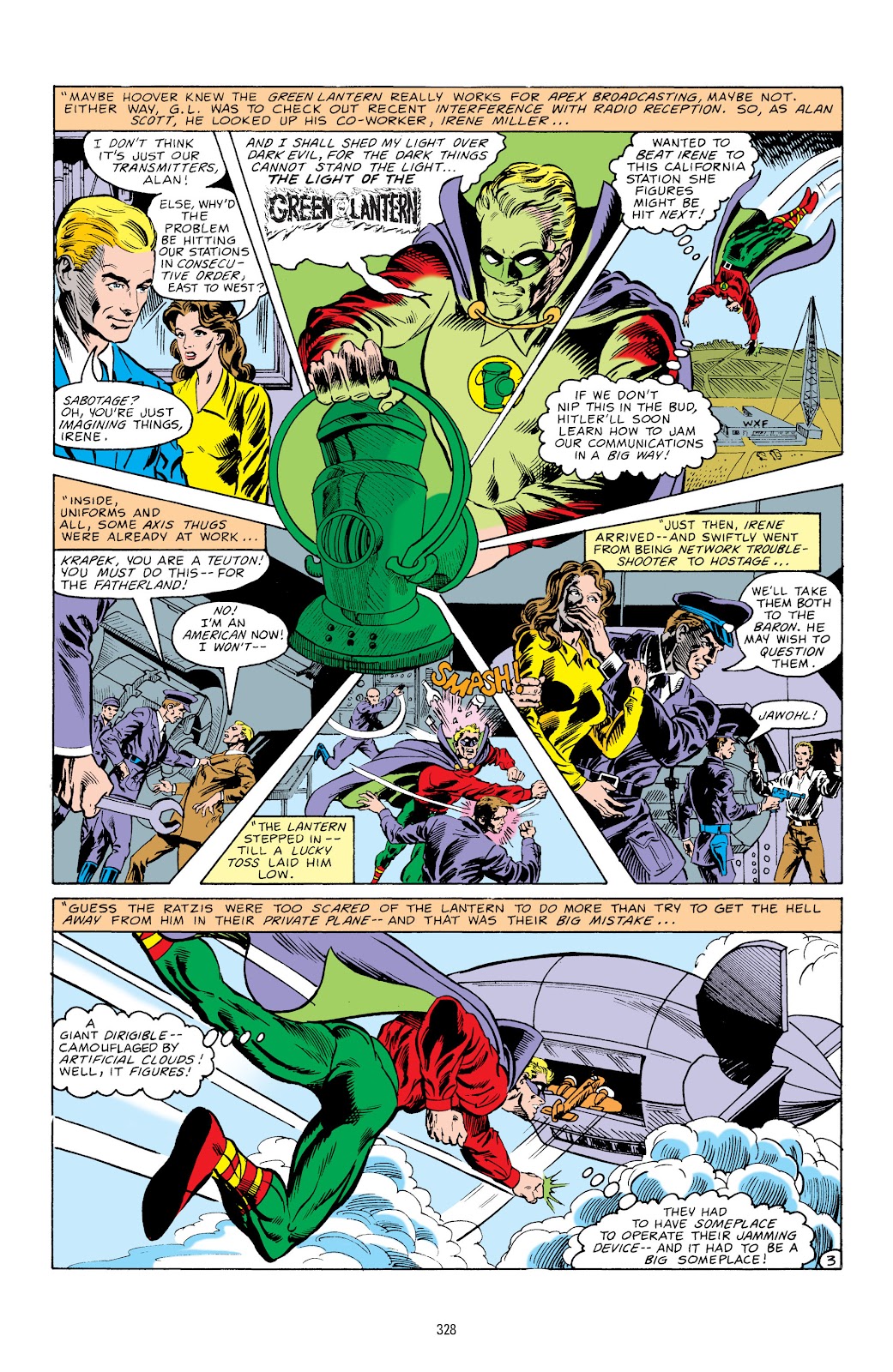 Hey, cool; they got a blimp! He defeats the Baron (Steve Forrest?), with the help of the German-American. Flash deals with Bundists, in Detroit, the Spectre handles sabotage at a munitions plant, Hourman handles murder at an oil field, and Dr Fate handles attacks on shipping, via pneumatic cannon! 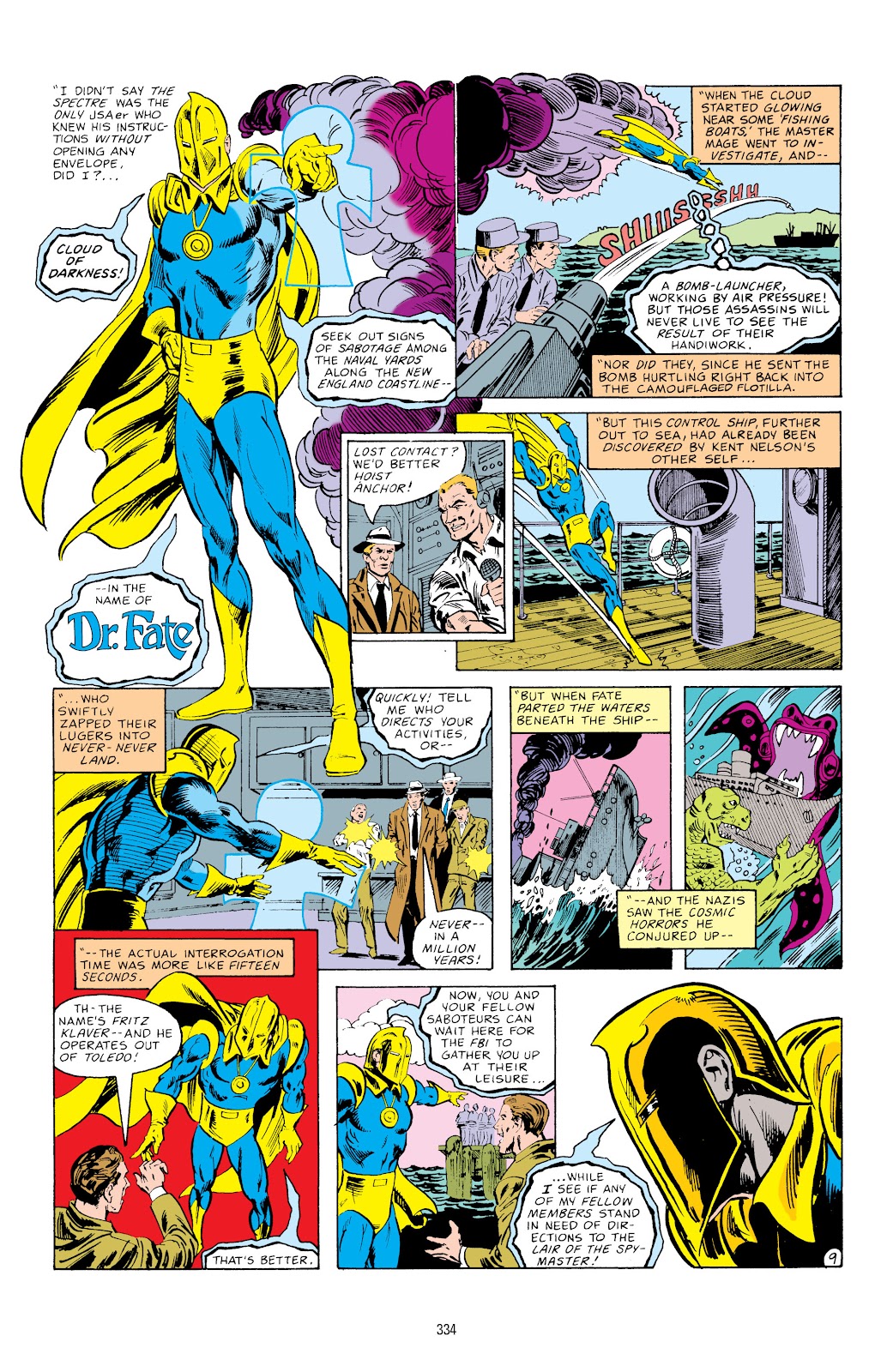 Sandman deals with an attempt to intimidate a publisher, in El Paso, Hawkman with sabotage of a B-17, and Atom deals with Ratzis on Campus... 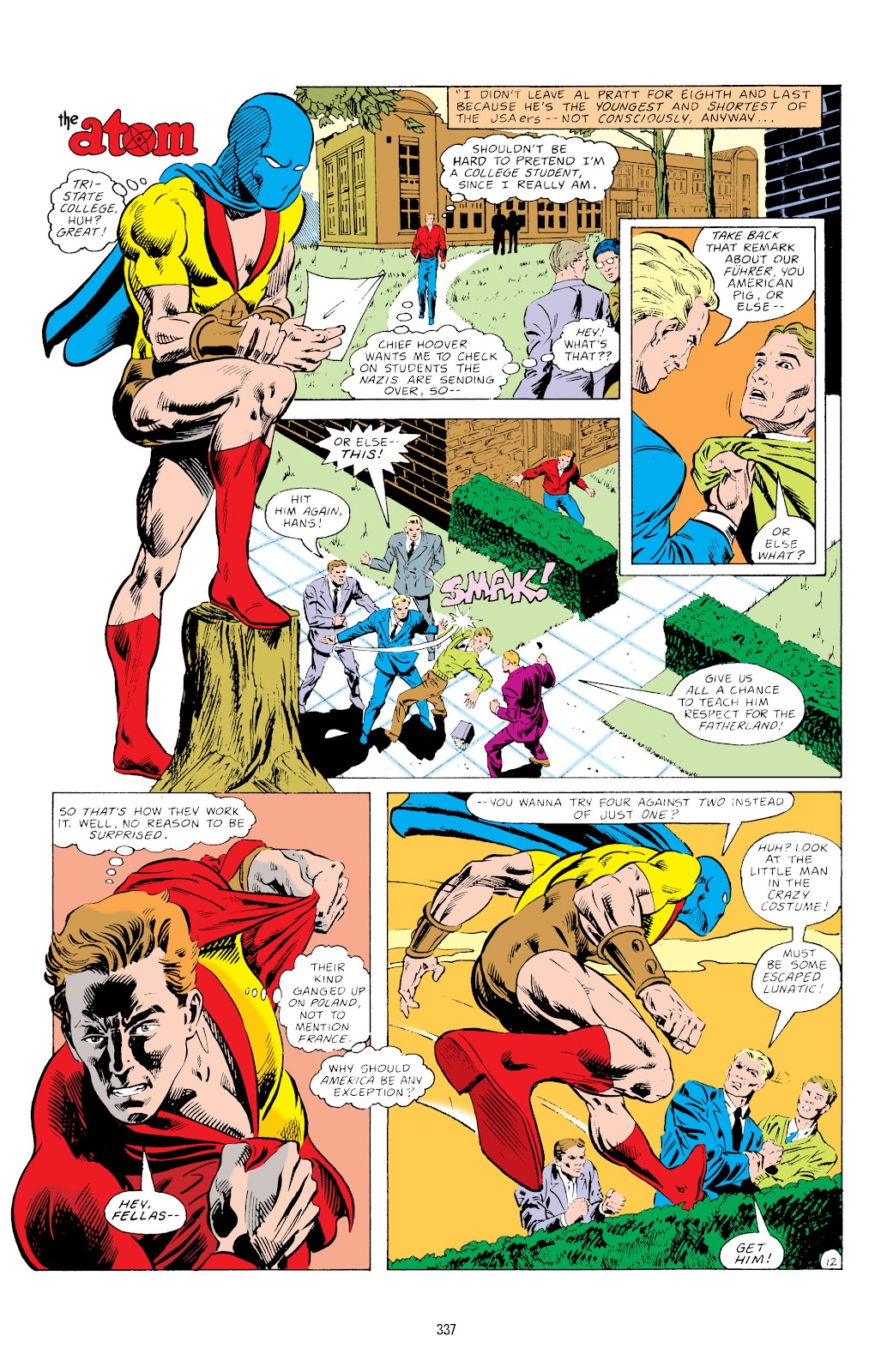 He gets caught and Johnny Thunder tries to help and gets caught, but the rest of the JSA turn up to smash some Nazi... 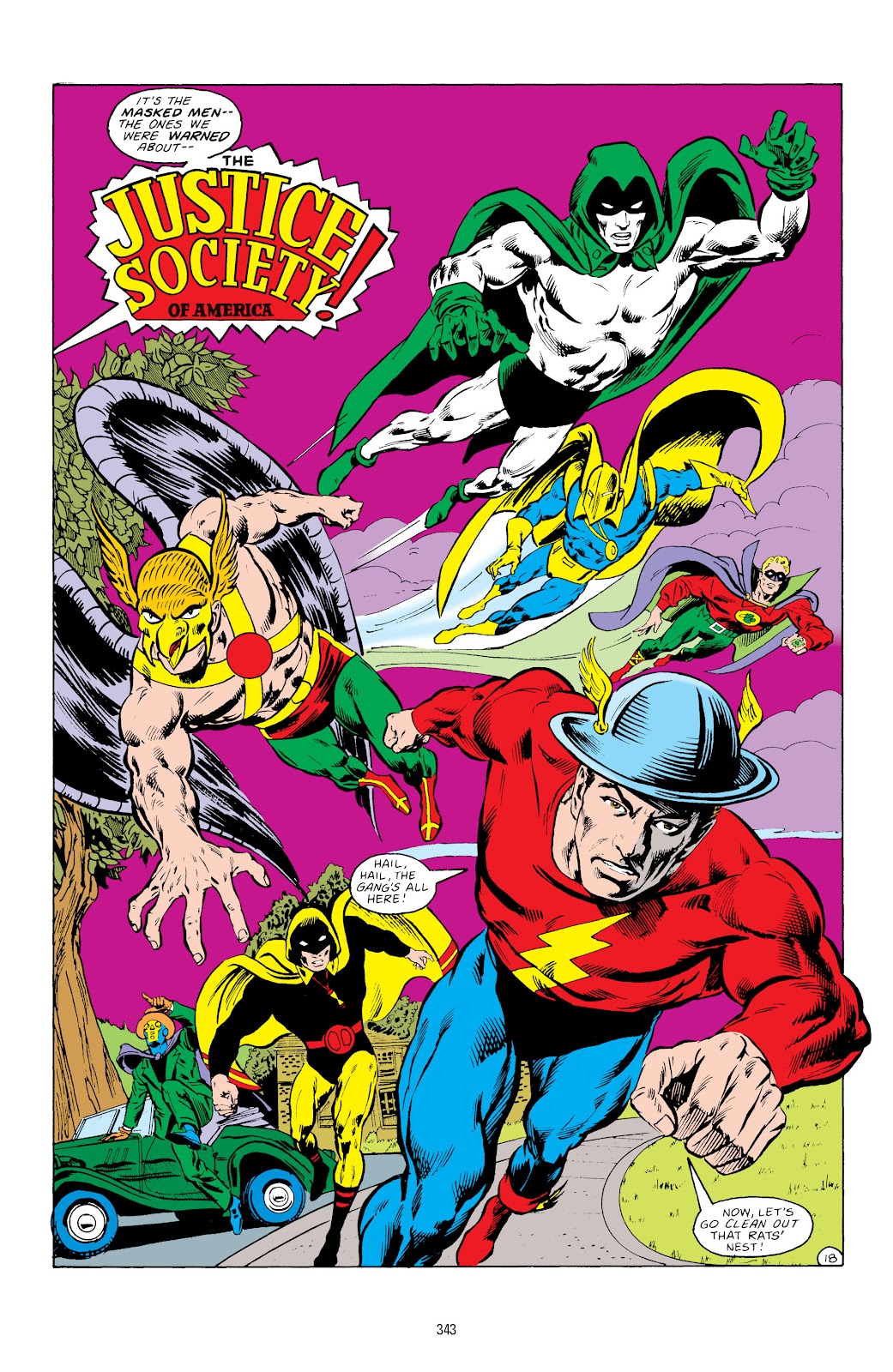 Not sure why they needed anyone but the Spectre... 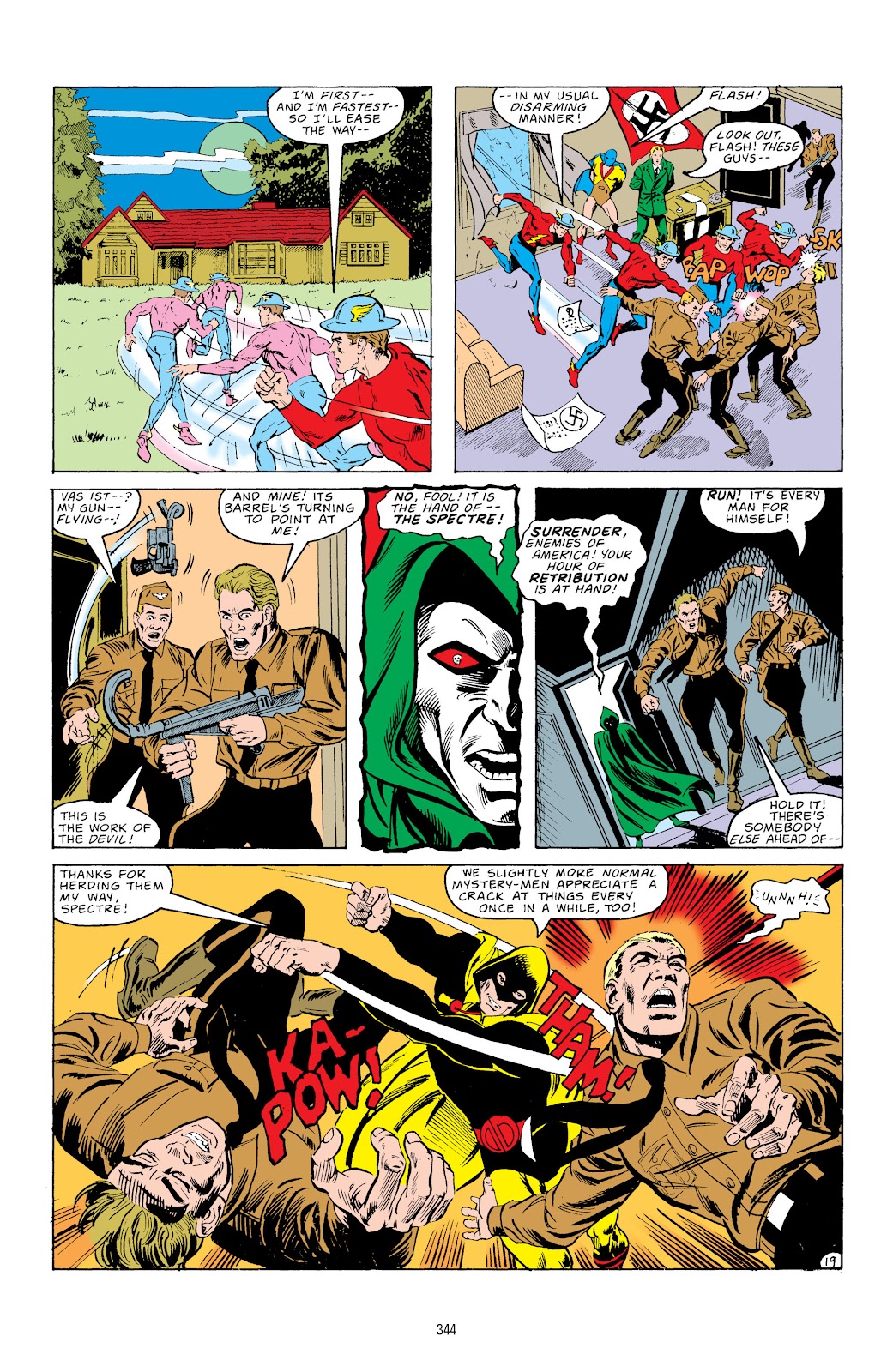 They win and report back to Hoover, who is ecstatic and then tasks them t infiltrate labor unions and Hollywood. Thoughts: Fairly pointless rehash of All-Star Comics #4, with some minor additions by Roy. Hoover was unseen in the original, but Roy had Arvell include him. Otherwise, this is a fan recreation of what came before, for Roy's own enjoyment. Nothing particularly bad about it, other than what was fresh in the 40s was pretty cliched in the 80s and it really served no purpose and wasn't exactly a high note to go out on. So, here ended The All-Star Squadron, which, quite frankly, ended just before Crisis threw a giant monkeywrench into things. I think part of the problem was Roy's obsession with keeping continuity with every minor story of All-Star Comics and other Golden Age funnybooks, coupled with the drastic changes wrought by Crisis. Roy's attention to the minutiae kind of crippled his reaction to Crisis, which he initially had a big hand in, but soon found that he was a minority voice and powers at DC were pushing for the JSA to be retired to keep the focus on the modern heroes. Roy pretty much checked out, at that point and the book suffered, compared to earlier issues. By this point, Roy is focused on his next project, which sought to provide stand-ins for erased continuity. We shall see if such a thing makes for good comics, as we move into the next phase. So, looking back at the series, as a whole, it is clear that the best stuff came in the first 2-3 years, both from a story standpoint and visually, with Jerry Ordway's artwork. Arvell Jones and Mike Clark did some fine work, as did Richard Howell; but, it increasingly became Roys' fan-fiction and diverged into stories that weren't really wowing the audience anymore. Roy went through a similar thing with Invaders, as it was great, for about 2-3 years, then kind of lost focus, after battling Master Man and Warrior Woman, in Berlin. After that, it struggled to find a good antagonist to pit against the team and went back to the Axis uber-men at the end. Roy similarly struggles to do anything after he has played out Baron Blitzkrieg, as well as Per Degaton and Ultra-Humanite. His rule of keeping things in 1942 prevented him from using other supervillains, who hadn't appeared yet and he didn't come up with many great new ones. I think there were pockets of greatness, in the second half, but that the series was less consistent. I really do think Roy needed an outside editor to nudge him in a more engaging direction. From a history standpoint, Roy brought a lot of real world elements and highlighted some major events, such as the Detroit race riots, which was a watershed event in what woulld become the post-War Civil Rights Movement. He illustrated how Japanese Americans were incarcerated without trial and presented two different outlets for their anger, via the Japanese agents attempts to use Nisei as saboteurs and the Nisei standing with their fellow Americans, despite their treatment. We saw Mexico, in 1942, things like the Normandie fire and the Battle of Los Angeles (with a slight twist, thanks to Per Degaton). Roy got to play with a lot of toys, including the Marvel Family and the Freedom Fighters. Really, I think the Freedom Fighters and the non-JSA contingent were the better way to go to create ne stories, set in the period, and not run afoul of DC editorial changes. Next, we move on to Young All-Stars, as Roy attempts to replace the departed Golden Age heroes with new stand-ins, like Fury and Iron Monroe. Here again he has to tread a fine line in creating something new and paying tribute to the spirit of the past, without getting bogged down in the minor details of old stories. since Crisis said those stories didn't count anymore, Roy actually had a chance to say what did and did not count, besides the existence of Superman, batman and Wonder Woman, in 1942. Historical Notes: J Edgar Hoover was implied but unseen in the original story, but is front and center here. The FBI were tasked with counter-intelligence and actually scored a major coup, in 1941, when it rounded up more than 30 members of the Duquesne spy ring, which had been set up to spy and commit acts of sabotage, should the US become involved in the war. The Bundist leader Fritz Klaver is based on real Bund leader Fritz Kuhn, who actually met with Hitler, in 1936, but was considered unreliable and the Nazi government distanced themselves from the American Bunds. As noted in my Jokes, Hoover was far more obsessed with Communist subversion than Nazi, until war was on the horizon. A 1942 attempt to infiltrate saboteurs fell apart not due to the FBI's efforts, but because of the betrayal of one of the members of the ring, who turned himself into the FBI after they didn't believe a phone call he made, telling them of the plot. Much of Hoover's FBI activities centered around investigating union organizers, Hollywood stars, writers, artists, publishers, and leaders of the Civil Rights Movement, while Hoover was notoriously soft on Organized Crime, leading to conspiracy theories about the mob having blackmail information about Hoover's alleged homosexuality and/or transvestism. The whole story is mostly conjecture; but, what is fact was that Hoover dominated the FBI into the 1970s and more major mob convictions came after his death, than before. April 1945- On Bougainville Island, Australian troops defeated the Japanese in the decisive Battle of Slater's Knoll. The Japanese had committed so much focus on attacking the Australians, they had no congencies for losing the fight. As such, after suffering huge losses, morale plummeted and desertions increased. The real story in the Pacific came on April 1, as American forces began the invasion of Okinawa. Now, for the first time, America wasn't retaking lost territory, blocking Japanese offensive strategies, or seizing islands to use as bases. Now they were attacking traditional Japanese territory. The objective was to seize the island for use as a staging ground for the invasion of the Japanese Home Islands. To do this, the largest amphibious landing, in the Pacific Theater, was carried out. To carry out the invasion, a new group was assembled: the 10th Army, a joint formation of the uS Army and Marine Corps, with its own tactical air force and support personnel. Approximately half a million men comprised the force, including support troops, as well as combat forces. The Japanese described the invasion as a "typhoon of steel," given the amount of armored units, amphibious landing craft, ships and aircraft that assaulted the island. Fighting raged on the island until July 2, by which point over 50,000 American casualties (about 12,500 dead and 4 times as many wounded), 84-117,000 Japanese and roughly half the Okinawan pre-war population was killed in the fighting. Large amounts of soldiers and civilians committed suicide, rather than be captured, as propaganda had convinced them of savage treatment by the Americans. Fighting was so intense that the distinction between soldier and civilian deteriorated and there were instances where civilians were deliberately killed. There were suicide attacks on land and masses of kamizae attacks on the US fleet. 15 amphibious ships were sunk, with 9 other vessels, as well, plus numerous others badly damaged in the attacks. In his graphic novel memoir, A Sailor's Story, author/illustrator Sam Glanzman, who served on the USS Stevens, off Okinawa, displayed the horror of the attacks, as planes kept coming at them, through a hail of anti-aircraft fire. The play and move, Mister Roberts, concludes with news of the kamikaze attacks off Okinawa. The final segment of HBO's The Pacific, is based on Eugen Sledge's memoir, which detailed his experiences on Okinawa, which left him traumatized for many years after the war.   24 Medals of Honor were awarded for actions on Okinawa. One of the most extraordinary recipients was Corporal Desmond Doss, a combat medic. Doss was a Seventh Day Adventist and pacifist. He had a job as a joiner, at the Newport News shipyard, which gave him a draft deferment; but, he chose to enlist in the US Army, and was assigned to the 77th Infantry Division. During fighting in Guam and the Philippines, he had earned two Bronze Star for valor, aiding wounded soldiers while under fire. On Okinawa, at a place called Hacksaw Ridge, his unit came under heavy Japanese counter-attack, with heavy casualties, with many cut off from the main body. Doss responded to cries from the wounded, giving them aid and carrying them to safety, lowering them down the side of the escarpment, via ropes. He then turned around to go back and find more wounded. Each time, he treated their wounds, dragged or carried them to safety and lowered them down the escarpment. He went in under shellfire and small arms fire to treat wounded men and bring them to safety. he was himself hit in the leg and treated his won wounds and waited five hour for stretcher bearers to reach him, after aiding others. While he was carried out, they were hit again and he crawled off the stretcher to aid wounded and suffered a compound fracture of his arm, which he splinted, himself, with a rifle stock and then crawled 300 yards, over rough terrain, to an aid station. It is estimated that doss saved the lives of between 50 and 100 men on Okinawa and he did it without taking a single human life. 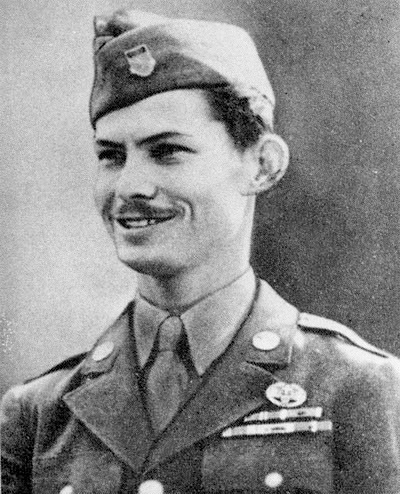 In relation to the Invasion of Okinawa, the Imperial Japanese Navy launched Operation Ten-Go, a suicide attack on the US Fleet, led by the battleship Yamato. Carrier-based aircraft attacked the formation before they were in range of Okinawa and sank the Yamato and 5 other warships, proving that air power had replaced the battleship in naval warfare. During the fighting on Okinawa, legendary American journalist Ernie Pyle was killed by a Japanese sniper. On April 7, the only flight of Sonderkommando Elbe takes place. This is a suicide unit, tasked with ramming enemy bombers, with the idea that the pilots would parachute just before collission. Unlike in the GI JOE cartoons, this was rarely successful. 24 B-17 and B-24 bombers were downed in the attack, but it does little to stem the tide of Allied bombing missions. The Germans lack sufficient fuel to mount major air defense. On the Eastern Front, the Red Army defeat the Germans and capture the city of Konigsburg, in East Prussia. Soviet troops also move on Bratislava and the outskirts of Vienna. Yugoslav Partisans liberate the city of Sarajevo and eject the German puppet government. The Red Army presses on to Berlin. In the West, the Canadian Army takes over responsibility for the Netherlands and isolates German forces in Atlantic Wall fortifications. They succeed in finally taking the city of Arnhem, one year after the failure to seize the Arnhem bridge in Operation Market Garden. US and British forces push Eastward. On April 11, elements of the US 3rd Army liberate Buchenwald and enter Hell. 4 days later, British and Canadian forces liberated Bergen-Belsen. On April 23, Flossenburg is liberated, but not in time to halt the execution of German Admiral Wilhelm Canris and his Abwehr (German Military Intelligence) co-conspirators, who passed information to the Allies, along with dissident pastor Dietrich Bonhoeffer, who were executed on April 9. On April 29, US forces liberated Dachau, the oldest of the concentration camps. At Buchenwald, Gen Patton, after seeing the horrors, ordered all German civilians to be paraded through the camp and witness what had been done to their fellow men Similar actions occur at other camp liberations. At Dachau, SS troops were shot and killed by US soldiers, acting in reaction to what they had witnessed. Dachau was a large complex, with sub-camps, who were liberated in turn, including one by the 522nd Field Artillery Battalion, a Nisei unit and also found a contingent of prisoners on a forced death march and intercepted them. On April 12, President Franklin Delano Roosevelt died suddenly, n his retreat at Warm Springs, GA and Vice President Harry S Truman is sworn in as the 33rd President of the United States. Roosevelt had been in poor healt since the Yalta Conference and was sitting for a portrait, when he complained of a terrific headache, then slumped forward in his chair. He died of a brain hemorrhage. His body was brought back to Washington via train, with thousands coming out to pay their respects to the man who had been president since 1933, carrying the country out of the Great Depression and into and through World War 2. He missed the end of the war in Europe by just under a month. On April 16, the Battle of Berlin begins. The Red Army attacked on 3 fronts, with two Army groups positioned on the South and East and one in the North. Stalin was desperate to take Barlin to ensure that the Allies would uphold their agreement for a Soviet Occupation Zone and had fought hard to encircle the city. The main body was led by Marshal Georgy Zhukov, one of the Red Army's most capable and successful generals. In the West, the Allies ceded Berlin to the Soviets, as it was unlikely they could reach the city in time and the very real possibility of friendly fire losses by engaging 3 separate armies seemed unnecessary. Hitler, upon receiving the news of the death of Roosevelt briefly though this might cause a falling out with the Allies, but reality soon set in. Fighting in Berlin was intense as city blocks were turned into defensive positions and battles were fought just to take a few floors in a building. Soviet artillery pounded the city at close range. Much of the German defense consisted of Hitler Youth, armed with Panzerfaust rockets, to try to knock out Soviet armor. Ammunition, fuel and other supplies were long ago spent in fighting and resources were at critical shortages, but the Germans fought hard, fearing the Red Army more than the british and Americans. By April 29, the Red Army was fighint for control of the Reichstag. On April 20th, Adolf Hitler emerges from the Fuhrerbunker to decorate a group of Hitler Youth soldiers. It would be his last appearance outside the bunker. on the 22nd, he receives word that Felix Steiner cannot raise enough forces to launch a counter-attack on the Soviets and Hitler privately concedes that the battle is lost. On the 23, Hermann Goring sends a telegram asking if he should assume leadership of Nazi Germany. Hitler regards the act as treason. On April 29, Hitler marries his younger mistress, Eva Braun, in a private ceremony and signs his last will and testament. On April 30, Braun takes poison and Adolf Hitler shoots himself in the head with his service pistol. His body is burned to keep it from falling into the hands of the Soviets. Grandadmiral Donitz becomes President of Germany and Joseph Goebbels the Chancellor. Goebbels and his wife murder their children and then consume poison, dying in the Fuhrerbunker. On April 25, American and Russian troops link up at the Elbe River. The Red Army raises the flag of the Soviet Union over the Reichstag...  In Italy, after Brazilian forces liberate Montese, major fighting comes to a halt. on April 28, Benito Mussolini and his mistress, Clara Petacci, are captured by Partisans, as they try to flee the country. They are executed and strung up by their feet from lamp posts, for all to see. The next day, the Germans and Fascist Italian forces sign the unconditional surrender of Italy. In essence, the war in Europe is over in all but an official surrender. That will come swiftly. In the Pacific, the fighting will continue on Okinawa, through the month of May and June. The fighting will be some of the bloodiest and other horrors will live in the minds of survivors for decades to come. For some, April brought a rebirth, as they were freed from the horrors of the death camps and given a new life, to return home or settle in new countries, start families and remember those who did not survive and ensure the world would never forget what happened in the Holocaust. I think the child of one such survivor, Geddy Lee, of Rush, captured it pretty well, in 'Red Sector A"...
|
|
|
|
Post by codystarbuck on Apr 3, 2021 15:53:53 GMT -5
ps For those interested, Geddy Lee talks about his family's history, in the Holocaust.
|
|
|
|
Post by codystarbuck on Apr 9, 2021 14:26:37 GMT -5
Okay, we enter the new phase of the All-Star Squadron. With Crisis throwing a monkey wrench into Golden Age DC continuity, completely wiping away Earth 2 and much of its history, a lot of the foundation of Roy's comic was stripped away. As we saw, Roy started in the book to work on continuity fixes for old stories; though, quite frankly, I don't think anyone cared that a Superman story about comic strips coming to life and wondered how it now fit into DC history. Not every story had to count. However, Roy had a few problems on two fronts; one, he lost several characters from future use in the All-Star Squadron and their participation in past adventures was now history. Two, Roy had created legacy characters for the JSA and their history was now affected, especially Lyta Trevor, aka Fury.  Lyta was introduced as the daughter of the Earth-2 Wonder Woman and Steve Trevor, in the 300th issue of the WW series, which Roy was writing. In that story, she is just a teenager, who is wowed by a visit from her "aunt" Diana, of Earth-1. Then, Roy launched Infinity, Inc, both in the pages of the All-Star Squadron and their own title, with Lyta now a superhero, Fury, alongside Hawkmans's son hector (aka Silver Scarab) and protege Northwind, Atom's adopted (sort of) grandson Nuklon (the future Atom Smasher), Green Lantern's twin children Jade and Obsidian (implied at first, confirmed as the series went on), Brainwave Jr, son of the JSA enemy and established legacies Huntress and Power Girl, plus the Star Spangled Kid (who joined the JSA with the 70s All-Star revival, as part of the Super Squad, with Power Girl and Robin). That was fine, until Crisis wiped away Huntress and messed with Power Girl's origin (she became the grandchild of Arion, of Atlantis, which got further F-ed with) and stripped away the existence of a Golden Age Wonder Woman. Fury remained (since they had trademarked the name) but had no parents. Roy first addressed it in Infinity, Inc #35, where the Infinitors run up against Injustice, Unllimted (the second generation Injustice Gang). During the story, the members of the team are forced to aid the Injustice bunch in obtaining several items, for the Wizard. Fury is paired with The Shade and they goe to Greece, to the Aeropagus, the Hill of Ares. Fury falls into a crevice, while searching for a stone , which she brings out, to the Shade. At the start of the issue, we get a glimpse of our first continuity fix, as we see an image of the JSA, with a new member... 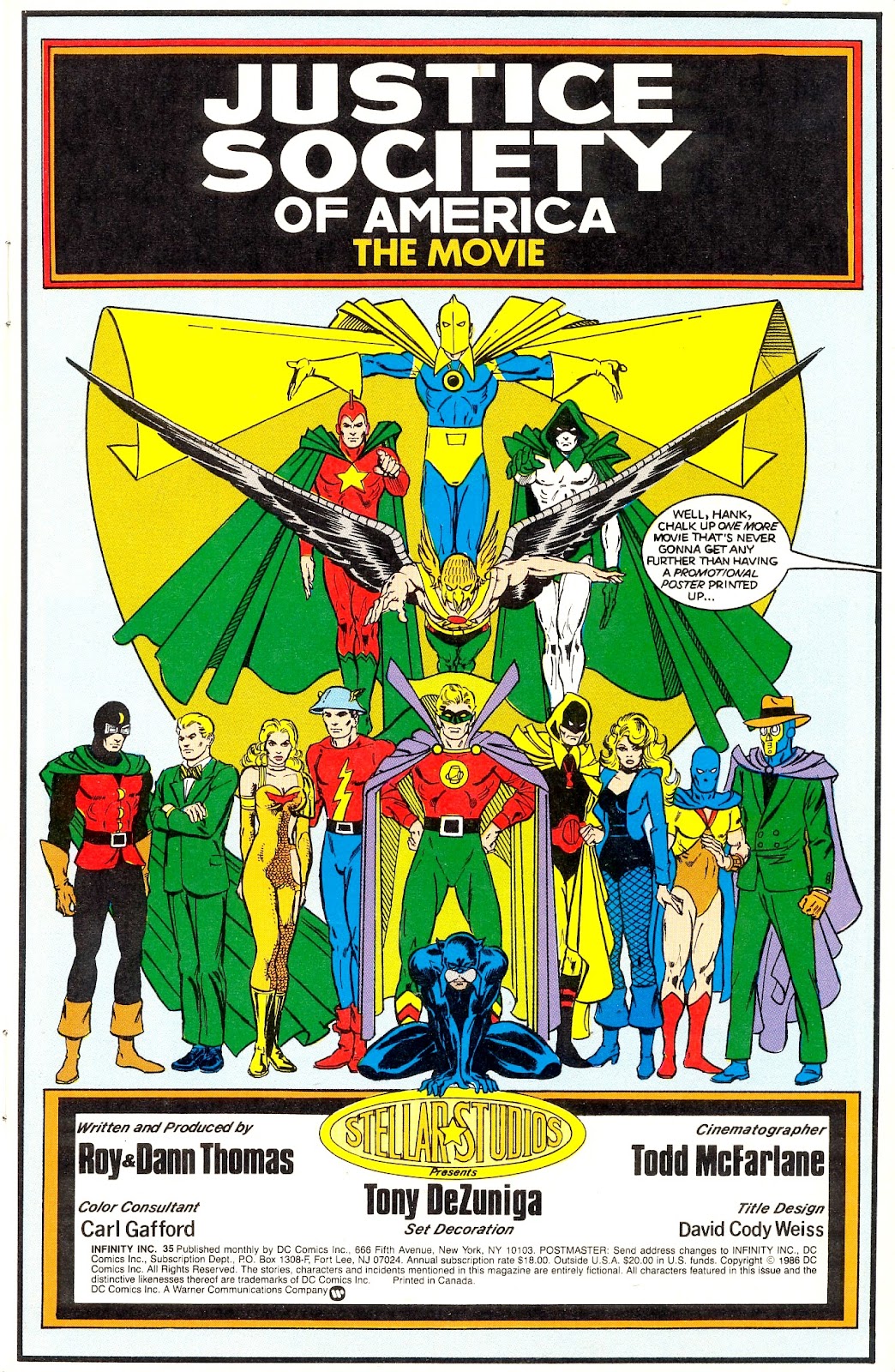 There, to the left of the Flash, we see a woman in chain mail, with a metal shoulder guard, similar to Fury's armor. She is not addressed further, in the story; but, if we zip over to Secret Origins #12 (also written and edited by Roy), we learn what happened in the cavern that Lyta discovered. She found a black onyx rectangular solid and touched it and the Furies of myth came forth. In Infinity, Inc, Lyta remarked that she had never been to Greece, but the Aeropagus seemed familiar. We learn why, as the Furies relate the tale of Helena Kosmatos, a Greek woman, during the Nazi occupation of the country. Helena lives with her mother and brother. her brother has been collaborating with the Nazis, to care for his family, which angers Helena. She finally confronts him and reveals the truth to their mother, who suffers a heart attack, from the stress and dies. Miachael runs off and Helena swears vengeance, as she hides from a German patrol and an earthquake occurs, swallowing her into a cavern, where she is presented the Furies and becomes possessed to be an instrument of vengeance, both against her brother and the Nazis. 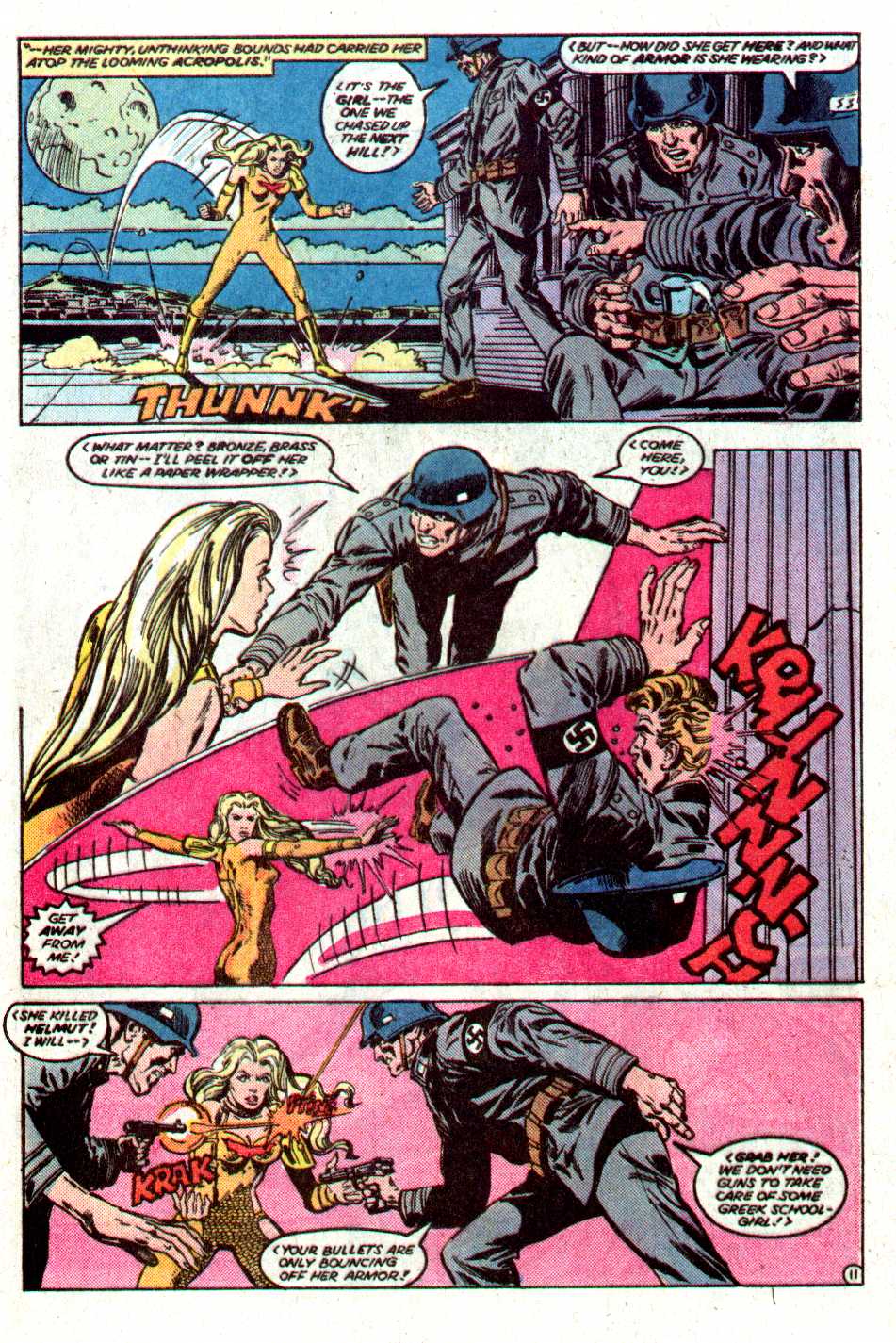 In a very rapey scene, Fury is down and straddled by a German soldier, holding a knife, as her body is vibrated by a quake, until she throws the man off and unleashes the supernatural power of the furies. Michael is then confronted and destroyed by one of the Furies and Helena is plunged into the Mediterranean, where a semi-conscious Helena is found, clutching the wreckage of Michael's smuggling boat. She is rescued and meets Johnny Chambers, a newsreel photographer. This sets the stage for Young All-Stars, Roy's new volume for the All-Star Squadron, as he seeks to replace the erased heroes of the Golden Age with new stand-ins, to fulfill their roles. fury, is the first, taking the place for Wonder Woman. We will next meet replacements for Superman, Batman and Robin, and Aquaman, while Tsunami will return to the book, to help add some ethnic and gender diversity, while also adding the plot element of a Nisei, in WW2, who had fought against the Squadron, previously. Now, time for the new launch. |
|
|
|
Post by codystarbuck on Apr 9, 2021 16:51:53 GMT -5
Young All-Stars #1 Here, we meet "Iron" Munro, which sounds like a Scottish pro wrestler. Creative Team: Roy & Dann Thomas-writers/editor, Michael Bair & Brian Murray and Vince Argondezzi-pencils, Malcolm Jones III-inks, Cody Weiss-letters, Carl Gafford-colors. Roy edits his own material, so I will dispense with editorial credit from here on. Synopsis: We open with visions of Mekanique whoopin' the tar out of the All-Stars... 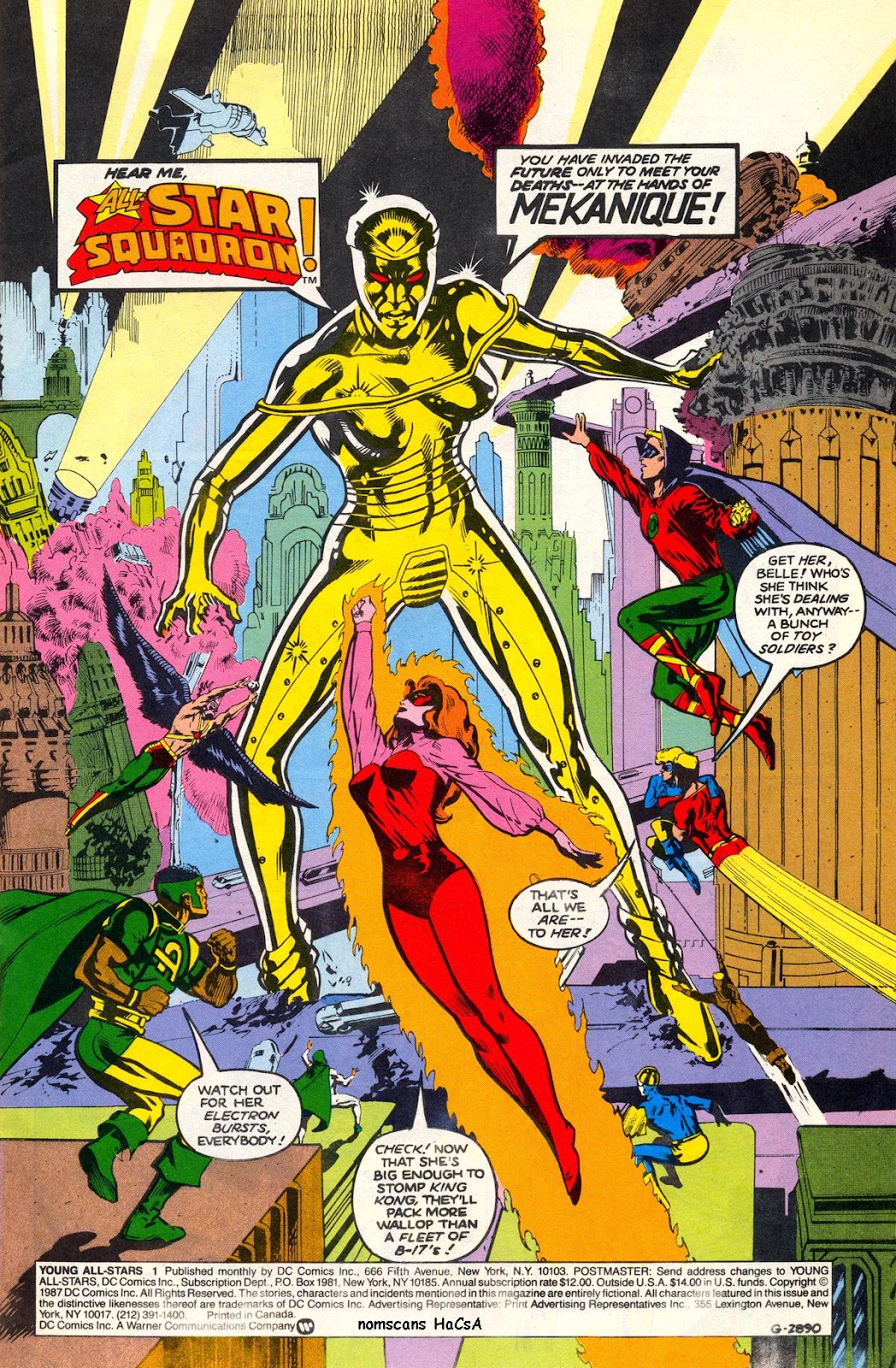 This goes on for several pages as she wipes out and kills all of the All-Stars, including Johnny Quick and is about to stamp on Liberty Belle, as she cradles the ehad of her fallen husband, when Libby Lawrence Chambers wakes up, screaming... 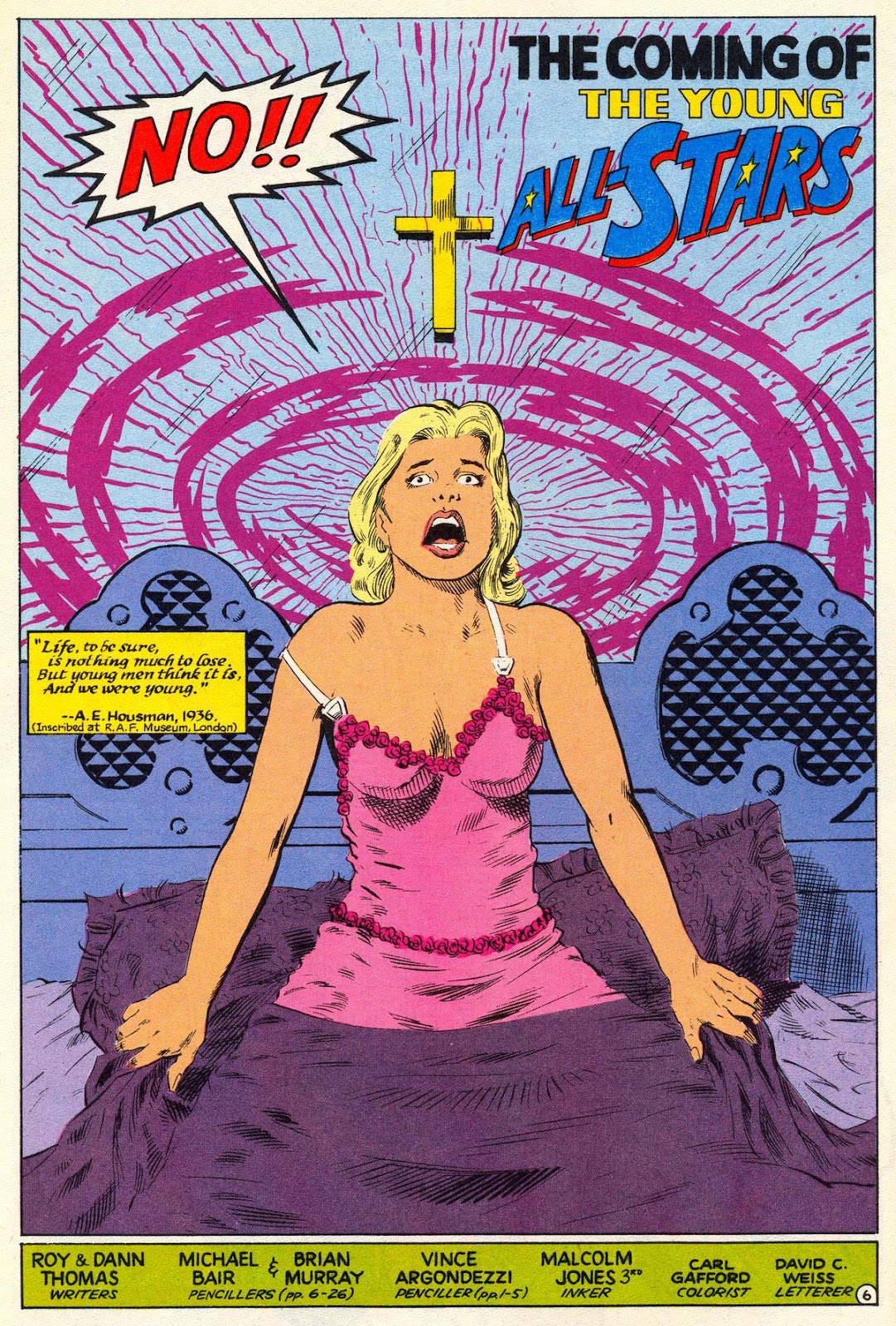 It was all a dream. Just a dream. Or is it? Well, yes, it is. Perhaps not. But probably. Maybe. 95% sure. Absolutely 80% certain it's a dream. 70-30. Whoops, it's not Libby who is dreaming, it is Helena, the young woman who was rescued by Johnny Chambers and the crew of the ship upon which he was travelling. "Uncle" Johnny comes rushing into her room, and comforts her, then "Aunt" Libby turns up and Johnny quickly switches to his Johnny Quick costume, revealing the truth to Helena, showing her that Johnny Quick and Liberty Belle are alive. Helena tells of her other dreams, of the Furies, as we recap the secret Origins story. A calendar also reveals it is still April, 1942. Johnny takes Helena and Libby for a flight to the Perisphere, to meet the other All-Stars, to show they are alive, but also to investigate how she knew details of their lives and adventures she hadn't encountered before. Meanwhile, off the coast of Santa Barbara, Neptune Perkins plays with dolphins and witnesses Tsunami messing with ocean currents... 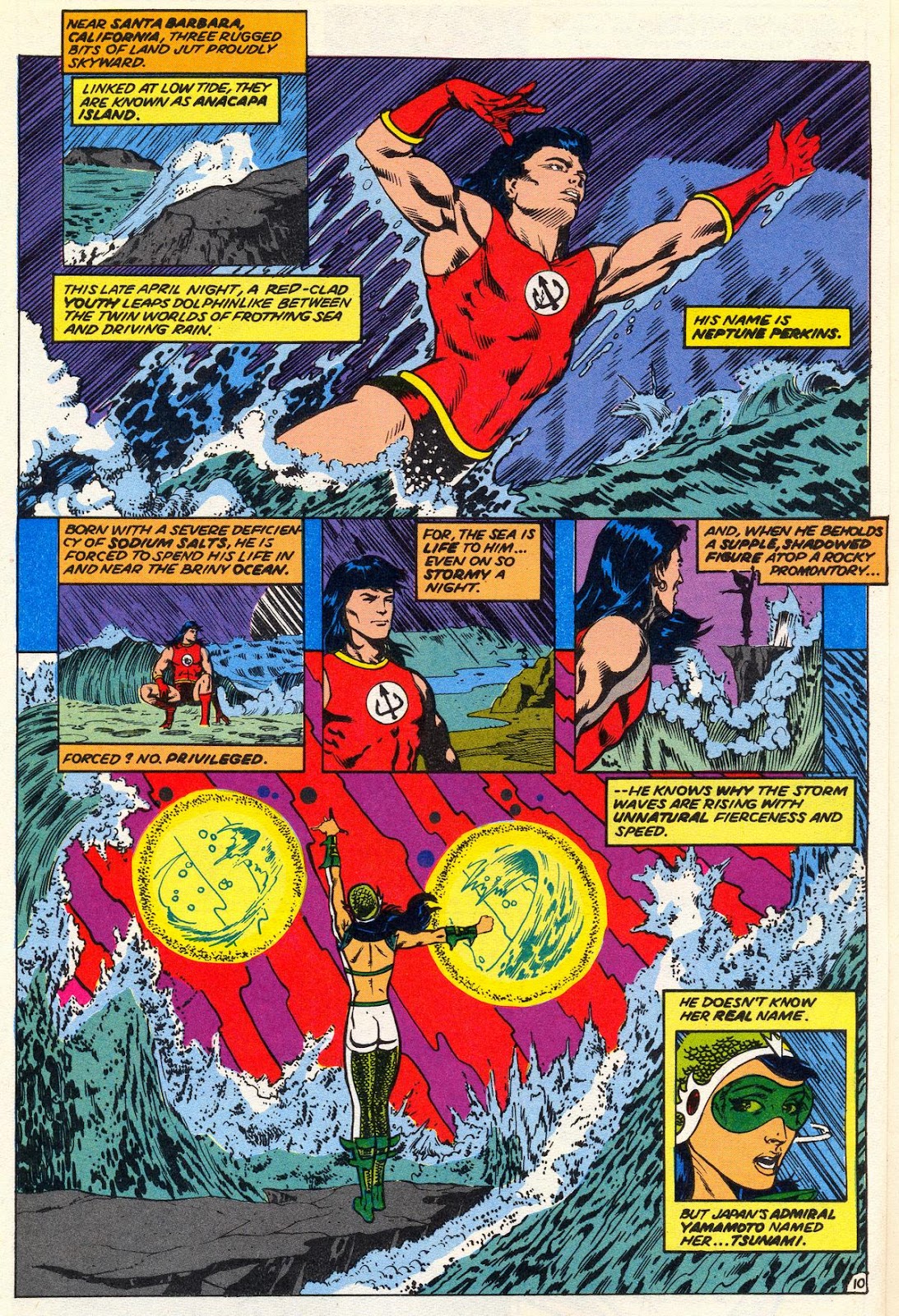 She cries out to him as he is about to be hit by huge breakers and then goes down to rescue him, after he is swallowed up by the mass of water. She pulls him out and they talk on his houseboat. He hints around about her origin and she reveals the truth. After their previous encounter, she went to see her parents in San Pedro, where she revealed what happened. her father urged her to turn herself in, but she tells him they will imprison her. He disbelieves and she reminds him of the Executive Order which give the government authority to imprison the Japanese-Americans without trial. Her father dismisses that as rhetoric, until two FBI agents barge into their home to arrest him as a spy. Tsunami reacts violently and hurls one into a wall, and faces down the other, who realizes she is the unknown figure that they had reports of, from her previous encounter. She runs and leaps into the ocean. Tsunami was looking to commit suicide, by tidal wave, when Neptune Perkins stumbled into the path. Neptune knows someone who may be interested in what she has told him and takes Tsunami with him, to tell this man of these occurrences. Meanwhile, a squadron of Spitfires is scrambled to investigate sightings of something moving south and spot a flying man, in a fox cloak... 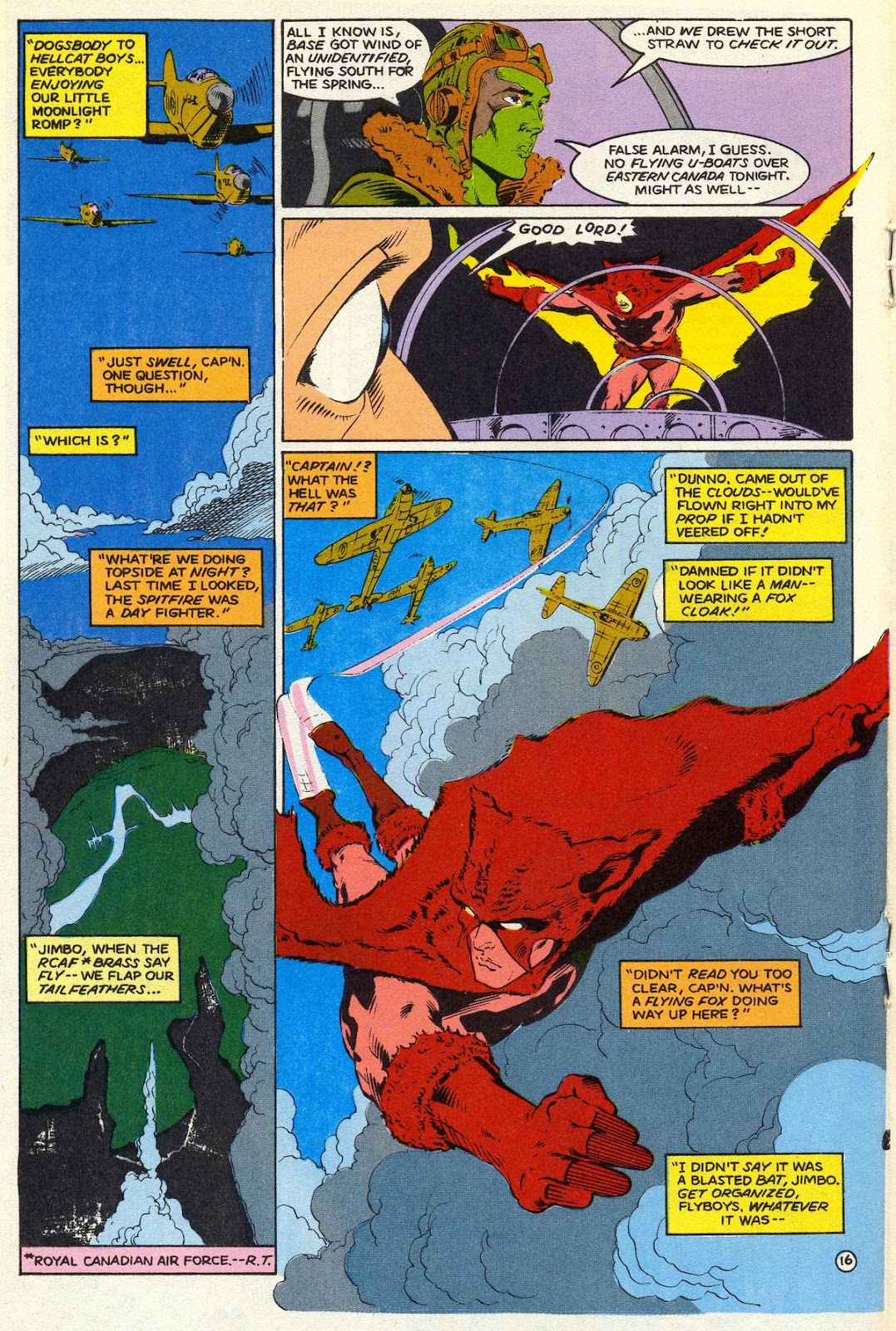 He creates a whirlwind and disappears, like one of the mystery men down south, as one of the pilots says. We then cut to a newly built hydro-electric damn, where Nazi agents are trying to commit an act of sabotage, but encounter the duo of TNT and Dan the Dyna-Mite... 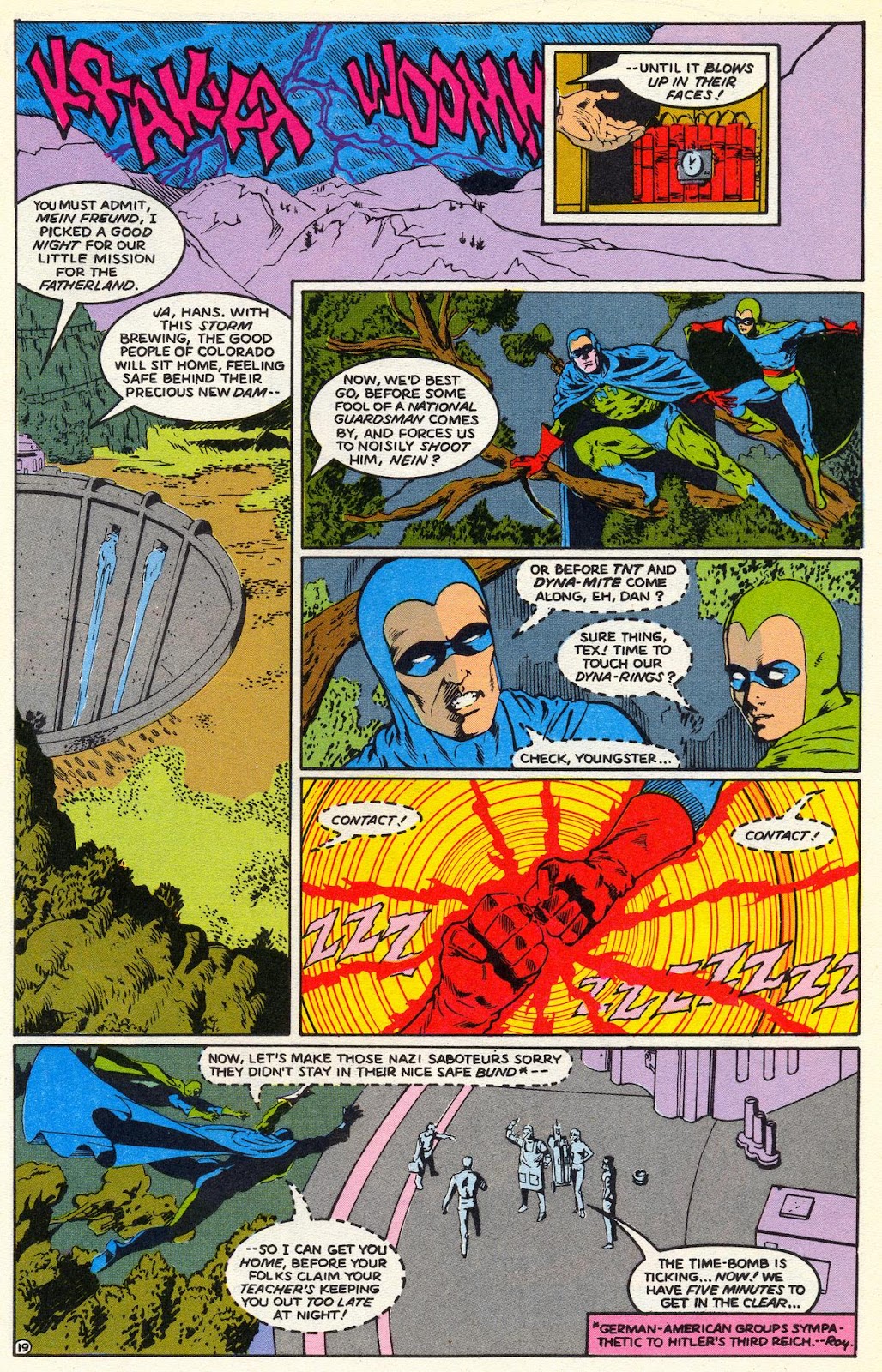 They battle and some of the Bundists tear away in a car and the explosive duo follow. The commotion is heard by one Arn Munro, who is busy romancing a gril named Dottie, with a nocturnal picnic (to watch the "submarine races," no doubt). Arn tells Dottie to stay there and goes to check out the gunshots. There is a chase and a gun battle and one of the Germans succeeds in hitting the Duo's car, sending it into a crash. They then look ahead and see something blocking the road and are unable to stop in time... 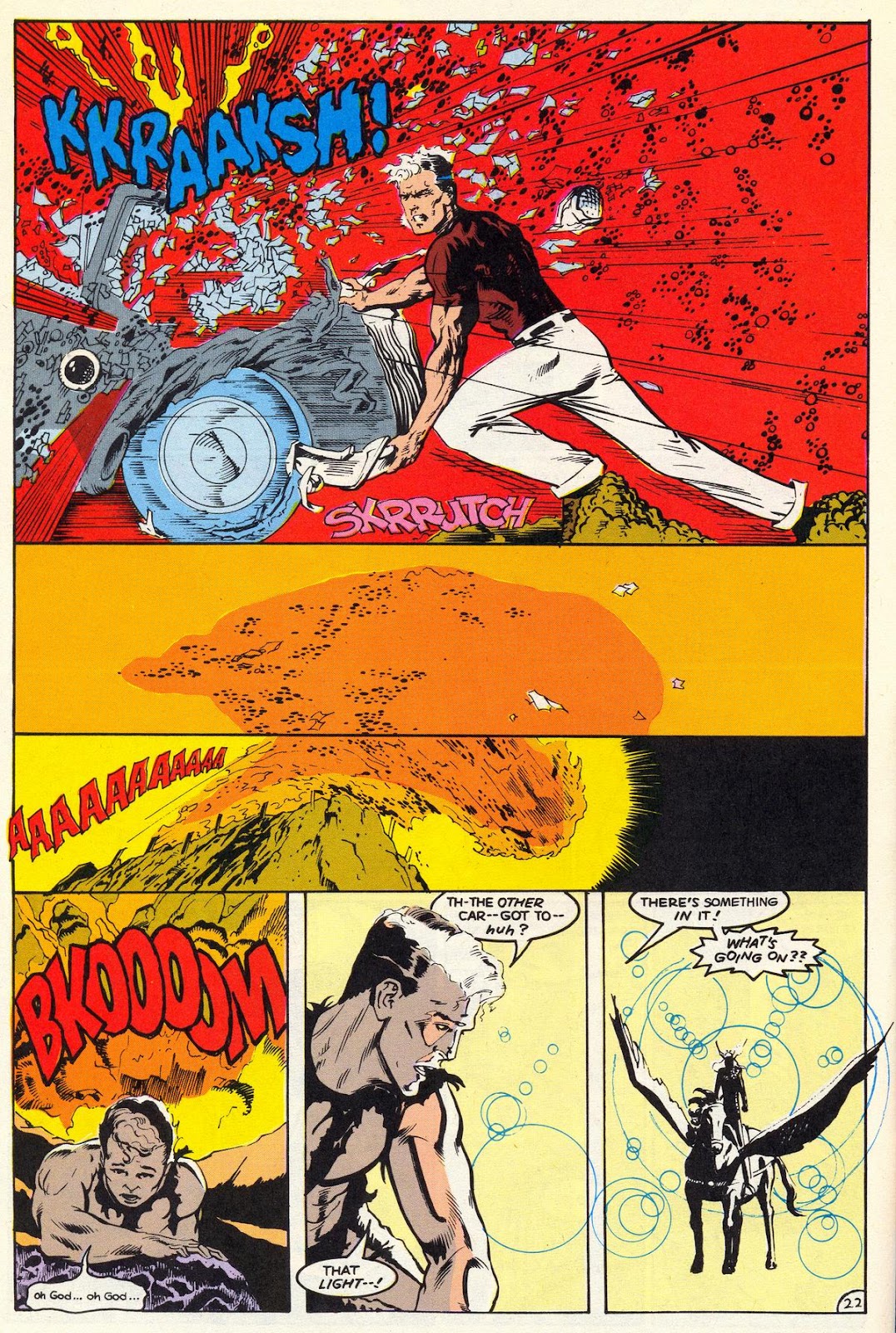 Arn drags TNT and Dan out of the burning vehicle. Dan moans, revealing he is alive, but TNT is dead. Then, a valkyrie, named Gudra, appears to Arn and says the hero is dead. She claims to be there to claim the fighting spirits of the duo. Arn protects Dan, who is still alive and spirits him away from Gudra's magic. Gudra rides off on a winged horse, to a nearby city, lands in an alley and touches a specific brick in a wall, which opens, revealing a secret entrance. She goes inside and joins the meeting of Axis Amerika... 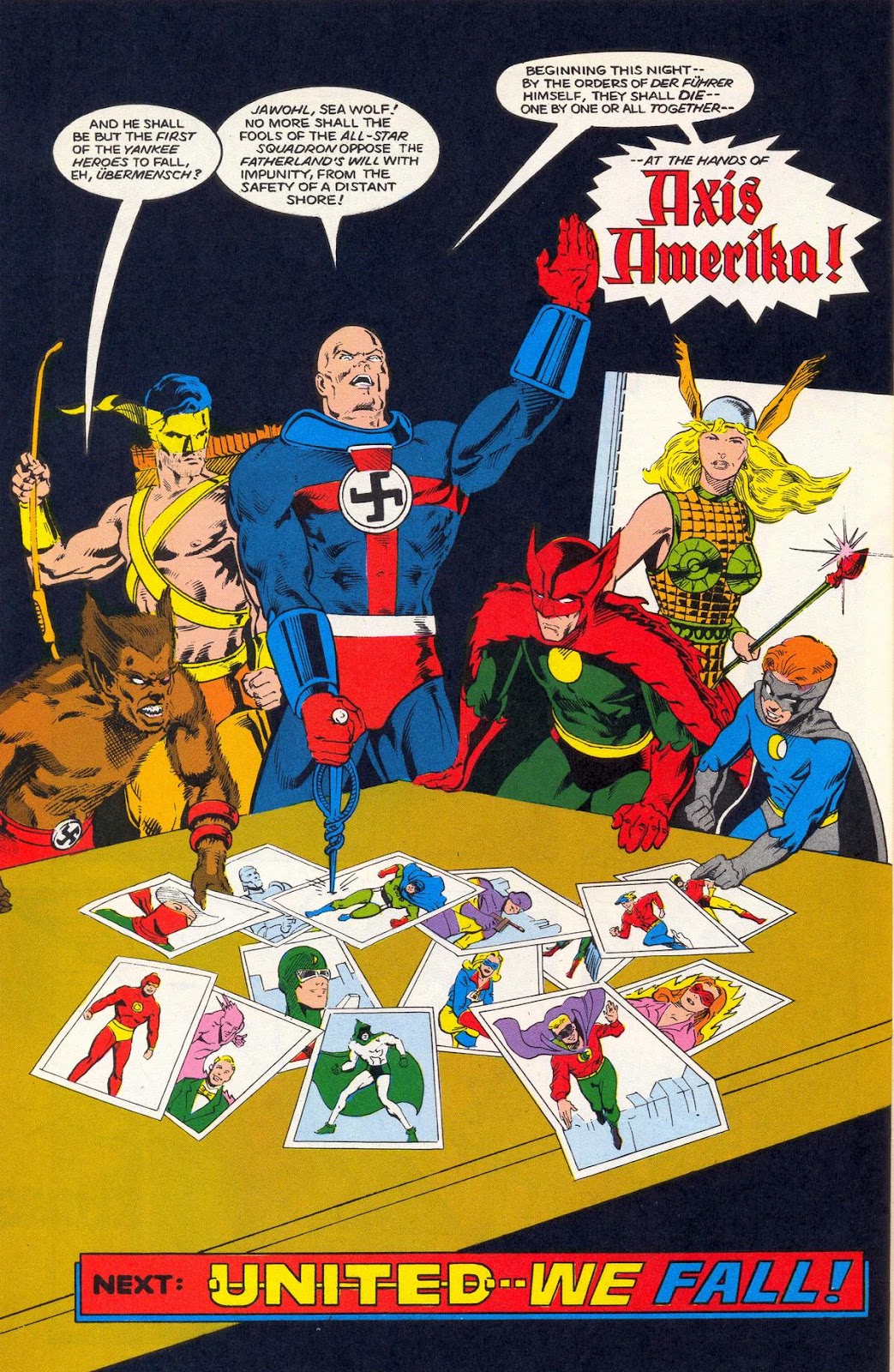 Thoughts: Thoughts: Okay....well, Roy hits us with a lot of introductions, but plenty of action during those introductions, making for an exciting comic. There is some mystery about Helena's dreams of death, Tsunami's actual transformation from Miya Shimada, an American-born student in Japan who returns to America as an agent of the Emperor (and the ruling military), who has abandoned her allegiances. We have no idea who the flying man is. nor Arn "Iron" Munro, other than he has a Scottish family name and a Scandanavian first name. Maybe his parents were fans of Prince Valiant. TNT and Dan the Dyna-Mite appeared at the mass meeting of the All-Star Squadron, but had little actual involvement in the adventures. Previously, they had appeared in a couple of issues of the Super Friends, the tie-in comic aimed at young children, who were fans of the cartoon. they were a sort of copy of Batman and Robin, though they had super powers, brought on by touching their rings together, giving them explosive force. So, here we have a new Superman, a potential Batman (with powers), a Robin, a new Aquaman (Neptune Perkins) and a Wonder Woman, with Fury. Tsunami helps round out the numbers and Johnny & Libby are there to provide continuity with the old series. It all looks very nice and certainly sets up an intriguing opening chapter. The appearance of Gudra adds a new twist, until we see her join the rest of Axis Amerika, taking a supernatural premise and switching it to a super-villain ruse. Is she really a valkyrie or just someone using the symbology? We get a quick peak at the rest of Axis Amerika, which reminds me of the Nazi band that fought the Invaders, with master Man, Warrior Woman, U-Man and Baron Blood, who were pastiches of the JLA. Visually, at least, there is the same dynamic going on with this bunch, as the big bald dude suggests Superman, Gudra Wonder Woman, Sea Wolf, the furry dude, suggest Aquaman (sort of), the archer suggest Green Arrow, and the owl-looking dude and the masked kid are the Batman & Robin duo. What, no Nazi Red Tornado? Originally, I skipped the series, after flipping through the first issue or two, as it didn't really immediately grab me, and I felt the old series had been played out long before it ended. looking at it now, the art is fine, though 3 pencillers adds for some confusion in story, though Bair & Murray do the bulk of it. curious how they worked as a penciling duo; did they alternate sections or what? Vince Argondezzi handles the opening dream sequence and leaves the rest to the other guys. I always liked Michael Bair on the JSA characters and was happy when he finally came onto Infinity, Inc, at the tail end, after some artist upheaval, when Todd McFarlane left. McFarlane drew Fury's debut image, while Tom Grindberg did the Secret Origins tale. The Infinity Inc issue is mostly a set up for the Secret origins story, since we only see Fury fall into the crevice and then later re-emerge. I have always been tickled by that issue, as it introduced Injustice, Unlimited, which was a nice contrast to the Infinitors, including Hazard, the granddaughter of The Gambler, one of the original Injustice Society. The amusing part, for me, was that McFarlane drew her in a sexy female version of a riverboat gambler, including a bodysuit and fishnet tights, ala Zatanna. McFarlane drew the seams of the tights in the front, making it look like she was wearing them backwards for the entire story. Don't know if Roy ever pointed it out; but, McFarlane was pretty much ignoring whatever anyone said to amuse himself, visually, with the pages of the comic, as he was bored by the stories. Back to Bair; he has a nice classic styling, mixed with modern technique, which adds nice pulpy touches to the Golden Age heroes, while presenting a modern look. There is a moody presence that is accentuated by Malcom Jones' inking (and other inkers that Bair had). So, after actually reading this, this looks pretty good; at least enough to make me want to read on and see how things play out, in this initial storyline. Historical Notes: Mostly, we are reminded of the rounding up of Japanese Americans on the West Coast and their imprisonment without trial. It is a shameful part of American history, following on similar actions with the herding of Native Americans on "reservations," as well as the ghettoization of ethnic groups and the institution of slavery. The "noble experiment" has always been flawed, sometimes deeply; but, it is the striving to do better for the next generation that propels things forward. Beyond that we have the stereotypical comic book "sabotage activity," which was relatively minor, in the US, thanks to early successes in rounding up German agents, like the Duquesne spy ring. With the war, the Bunds, which were never as big as comics made them out (as a whole, though some areas had more activity than others), lost any support and dissolved. Most members were not going to side with Germany against their home, though a few did, as there were recorded instances of Americans, by birth, serving in the Wehrmacht and SS, as well as in German propaganda. As the video mentions, there was also the British Freikorps, who were POWs recruited into the SS, to fight on the Eastern Front, though it was much smaller in numbers than propaganda suggested, with only 54 men identified as having served in at, at one time or another (with 27 being the maximum, at one time) Germany had cut ties with the Bunds, even before the US' involvement, as they were regarded as unreliable. May 1945;  On April 30, 1945, Adolf Hitler committed suicide and his body was burned. Grand Admiral Karl Donitz became President of Germany and Joseph Goebbels became Chancellor. The next day, Goebbels and wife Magda poisoned their children, in the Fuhrerbunker and committed suicide, also by poison. The Soviets announced the surrender of berlin on May 2. That same day, the surrender of all German forces in Italy came into effect and New Zealand Army troops entered Trieste, in Yugoslavia and accepted the surrender of the Germans, who surrendered to them, rather than the Yugoslav Partisans. The British took the city of Lubeck, on the Baltic. Members of the Nisei 522nd Field Artillery Battalion intercepted a death march of prisoners from Dachau. On May 3, Werner Von Braun and German rocket scientists surrendered to US forces and are brought to the US, under Operation PaperclipOn May 4, German forces in the Netehrlands, Northern Germany and Denmark unconditionally surrender to Field Marshal Montgomery, at Luneburg Heath, near Hamburg. Admiral Donitz orders all U-boats to cease operations and return to their home ports. On May 5, Prague rises up against the Nazis. The city of Amsterdam is liberated by Canadian troops. In the US, during a picnic of churchgoers, a Japanese "fire balloon" lands near Bly, Oregon and explodes, killing a woman and 5 children, as they try to drag it from the woods. They become the only casualties of an Axis attack on American mainland soil, during the war. That same day, the 11th Armored Division liberates Mauthausen Concentration Camp, in Austria. Among the newly liberated prisoners is Simon Wiesenthal, who will carry on a lifelong project of identifying and exposing Nazi war criminals, which included the arrest and trial of Adolf Eichman. On May 7, ay SHAEF HQ, in Reims, France, General Alfred Jodl signs the Instrument of German Surrender, the document outlining the unconditional surrender of all German forces to the Allies, which takes effect at 23:01 hours, Central European Time, on May 8. RAF Lancaster bombers land in Germany to begin the repatriation of British POWs to England, with some 4500 returned home in the ensuing 24 hours. May 8 is observed as VE Day, Victory in Europe, across the Allied nations and the formerly occupied countries. In London, the Royall Family greats the revelers, along with Prime Minister Winston Churchill... 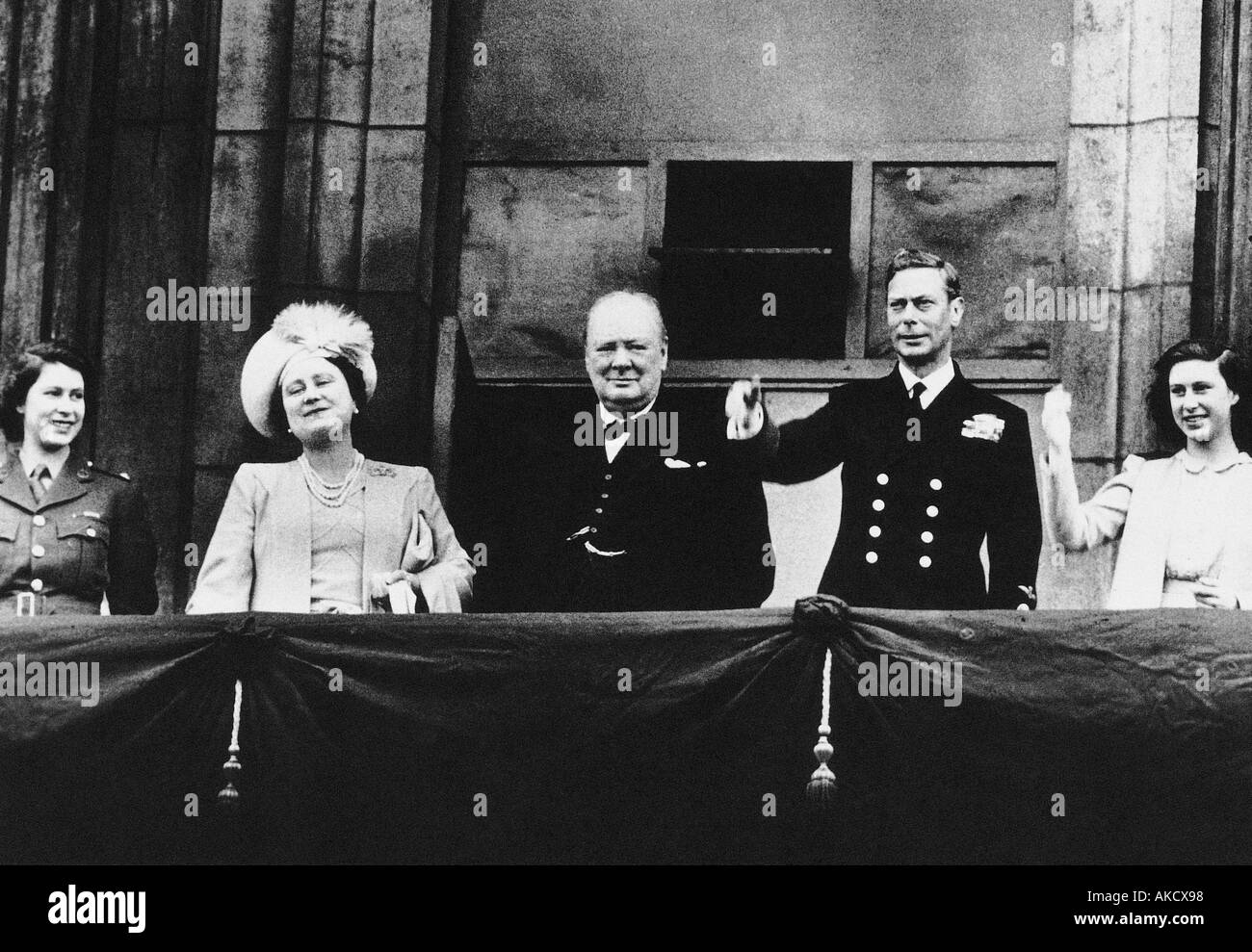 The Soviets observed VE Day on May 9 and the Red Army entered the city of Prague. That same day, Hermann Goring surrenders to the US Army. He would emerge as the highest ranking member of the Nazi Regime to be taken prisoner. He is tried at Nuremburg, for war crimes, was found guilty and sentenced to death by hanging. He asked to be shot as a soldier, rather than hung like a criminal and was denied. On October 15, 1946, he committed suicide, in his cell, with a potassium cyanide capsule that had been smuggled in. Over the ensuing days of May, German forces carried out the terms of surrender, as occupied territories were liberated and returned to either Allied or civilian administration and the process of prisoner exchange and repatriation began. In Europe, the war between the Axis Powers and the United Nations had come to an end, though civil wars would soon be sparked in some areas. The Allies turned to administering the newly liberated countries, re-establishing civil authority and beginning the Occupation of the former Axis states. All eyes now turned to the Pacific and the war with Japan, as fighting continued on Okinawa. The Russians are now freed to carry out their promise to join the war against Japan, though they will not engage Japanese forces until August.
|
|




